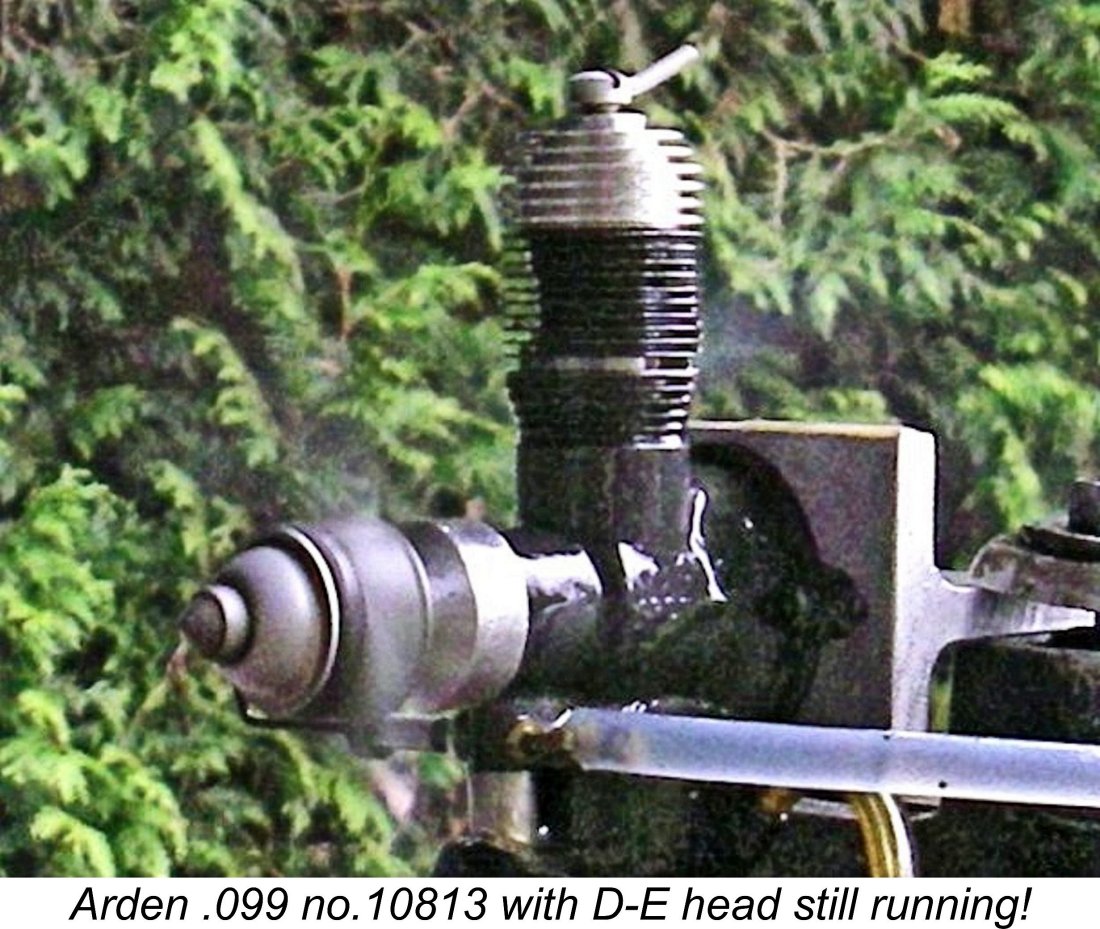
|
|
A Forgotten American Diesel – the Arden .099 D-E Diesel Conversion
The reason for the Arden engines invariably being omitted from listings of American diesels is that the compression ignition versions (of which there were several) were not purpose-built model diesels as such but rather were hybrid creations arising from the fitting of a commercial conversion offered as an accessory by a company other than the manufacturer of the engine in question. In my opinion, that in no way detracts from their claims to inclusion in the company of other American diesels. According to the late Tim Dannels’ outstanding “American Model Engine Encyclopedia” (AMEE), “numerous” examples of diesel conversions of both the .099 and .199 Arden models exist today. It’s thus clear that the operation of these engines in diesel form was widely practised or at least tried. In my personal view, this unquestionably places the converted Arden engines on the roll-call of commercial American model diesels, even if these engines are the result of a collaboration between the engine manufacturers and the independent producers of the diesel conversion components.
This first spark ignition unit weighed around 16 ounces and powered a six-foot wingspan model biplane of Ray’s own design and construction. A 14-ounce twin-cylinder powerplant followed in 1910. Interestingly enough in view of what was to come, Ray’s very first model engine featured a glow-plug in addition to the usual spark plug! This was not a true glow-plug engine since it ran on gasoline fuel and still relied mainly on the spark plug for ignition. However, the rather primitive jump-spark ignition system used in the engine was inclined to misfire at the higher speeds. The glow-plug apparently smoothed this out considerably. Ray went on to become a prolific inventor, creating a multitude of innovative designs which went far beyond the confines of model aviation. By the 1930’s he was focusing for the most part upon new toys, establishing his own company called Ultrad Products to develop his ideas into marketable products. In 1938 Ray received a call from the Polk brothers of New York, who had previously been involved with model trains and now wished to enter the model aero engine business. It was this call that got Ray back into the model engine field in which he had started. The call resulted in the 1939 appearance of the first of what was to be a series of Mighty Atom piston valve .097 cuin. motors which were manufactured by Microdyne America's December 1941 entry into WW2 put a stop to all model-related manufacturing as the USA focused its industrial capacity upon the war effort. However, following the formal Japanese surrender on September 2nd, 1945, it was back to business as usual. Ray immediately set about the development of his trend-setting Arden .099 and .199 spark ignition units which were manufactured beginning in early 1946 by the Micro-Built Corporation of Danbury, Connecticut. It is the smaller of these two models with which we are primarily concerned in this article. As history records, Ray went on to develop the first commercial miniature glow-plugs, which reached the American market in November 1947. The Arden engines were quickly modified to run on this form of ignition, with the timers replaced with light alloy front bearing covers and new black fuel-resistant tanks to replace the former clear units which were attacked by glow fuel. Ray also ceased offering the Arden engines in plain bearing form, feeling that the higher operating stresses imposed by glow-plug operation required the use of ball bearings. A full biography of Ray Arden by Charlie Reich may be found on the AMA website. Another highly informative article about Ray and his work may be found on the Internet Craftsmanship Museum website. Finally, there's an excellent Ray Arden tribute page which may still be found on the late Ron Chernich's "Model Engine News" (MEN) web-site. There's no reason whatsoever for me to repeat any of this material here, so we may as well zero straight into our main subject by reviewing the developments leading up to the application of compression ignition to the Arden engines, specifically the .099 cuin. model. The Model Diesel in America Development of the model diesel (or more correctly, compression ignition) engine was initiated in Europe prior to the onset of WW2 and continued in a number of countries throughout that conflict, as amply documented in other articles on this web-site. The compression ignition concept entered a rapid and very productive development phase in the years immediately following the conclusion of the war. At the time of which we are now speaking, the commercial introduction of the miniature glow-plug by Ray Arden still lay over two years in the future. Consequently, the early post-war model diesel powerplants were competing only with the well-entrenched spark ignition models for market attention.
The initial exposure of US enthusiasts to the model diesel came about in the latter part of 1945 as a result of the early post-war importation of wartime European examples, predominantly French and Italian, by servicemen returning from trans-Atlantic duty in WW2. An individual who somehow became aware of this new technology very early on was Jim Brown of Oakland, California, maker of the Thermite series of model spark ignition engines and later responsible for the manufacture of the Vivell range. In late 1945 Jim produced one or two prototypes of a very well-made .34 cuin. variable compression Thermite diesel. This interesting design used the eccentric main bearing form of compression adjustment which had been pioneered in wartime France. It ran very well, as my own tests have shown, but never made it into series production prior to Jim’s efforts being diverted to the manufacture of the Vivell range. I’ve documented the Thermite diesel story in a separate article to be found elsewhere on this website.
For context, it’s interesting to note that it was around this date that the first commercial diesels were just beginning to appear from British manufacturers such as Mills Brothers and Owat. It's an often-unappreciated fact that Britain was actually a latecomer in the field of commercial model diesel production, despite its later leadership role. Shortly thereafter, the first American-made commercial model diesels began to appear from a number of manufacturers. First among these were Barney Snyder and William (Bill) A. Ruff, who designed and manufactured the excellent 2.41 cc C.I.E. 10 diesel under the auspices of the Compression Ignition Engines Division of Modelcraft Hobbies in Los Angeles. This very capably-designed, well-executed and fine-running engine appeared on the market in late 1946. The full C.I.E. 10 diesel story is recounted in a separate article to be found on this web-site.
A number of these models possessed considerable merit by the standards of their day, regardless of from where one takes one's standards. Even the deservedly much-maligned Deezil was a perfectly acceptable product in its originally-released form before it was taken over and trashed down to a ridiculously low price and an even more ridiculously low standard of quality by Gotham Hobby - my own previously-reported tests of several early all-original examples have conclusively proved as much. There were also a few more “false starts” akin to the Thermite prototypes. In addition to the Thermite effort, model diesels were designed and brought to the prototype stage by EDCO, DeLong, AHC, Strato and Queen Bee (the latter two in Canada), although none of these appear to have entered series production. In view of the course of later trends in the model engine manufacturing industry, it came as quite a surprise to me initially to realize that there were almost certainly more firms engaged in model diesel development in North America at this time than there were in the emerging diesel stronghold of Britain! One designer who did not become involved with the construction of purpose-built diesel versions of his engines during this period was Ray Arden. However, he was clearly well aware of the concept of compression ignition operation. In the May 1947 issue of "Model Airplane News" (MAN), an advertisement placed by Arden manufacturer Micro-Built Inc. included the statement that these engines could be operated either on spark ignition or compression ignition with no mechanical alterations. Equal or better power was claimed using compression ignition. Full details were said to be forthcoming. Such details did indeed appear in subsequent editions of the Arden instruction sheets. The cited key to compression ignition operation was a combination of a special fuel and a hot engine. The idea was that one could dispense with the on-board spark ignition support system by starting the engine on spark ignition using a plug-in ground-based spark ignition support system, allowing it to warm up thoroughly and then disconnecting the ground-based ignition support system, upon which the engine would continue to run on compression ignition alone. The one additional requirement which this imposed was some means of stopping the engine in flight, since there was now no ignition system to switch off! Several special fuels appeared on the market which supposedly facilitated this form of operation using a variety of spark ignition models. These were marketed under the names "Liquid Dynamite" and "T.N.T." respectively. The Arden instructions specified a fuel blend consisting of 35% white gas (naptha), 10% ether, 10% spirits of gum turpentine, 20% nitroethane (a relative of the more familiar nitromethane) and 25% castor oil. The instructions claimed that compression ignition operation on such a fuel typically yielded more power and speed than on spark ignition. My good mate Maris Dislers actually tried to brew up a batch of this stuff to run a test on an Arden sparkie, but found that the blend wasn't miscible! This being the case, one wonders where this recommendation came from .......... I'm currently not aware of any successful latter-day experiments along these lines.
Full details of the Arden recommendations for compression ignition operation were included in an article by Ray Leone which appeared in issue 241 (November 2017) of the late Tim Dannels' indespensable but now sadly discontinued "Engine Collector's Journal" (ECJ). Our thanks are due to Ray and Tim for their efforts in documenting this very interesting facet of the Arden story. None of this had prevented others from taking a good look at the twin ball-race Arden .099 and .199 cuin. models and deciding that they could develop means to make these engines work even better in compression ignition form. Notable among these others was a company called D-E Model Products of Rockville Center, New York, who decided that the most promising avenue to explore would be the application of variable compression to permit full control of the ignition timing. They decided to develop means to meet this requirement. The D-E venture represented a partnership between designer/machinist Joe Dale and marketing expert Bill Effinger. The D-E diesel heads, the D-E fuel shut-off valve and the later D-E Super Aerotrol R/C systems were all marketed by Effinger through his Berkely Models Inc. company of Brooklyn, New York. The D-E Variable Compression Head
A simple screw-in fixed-compression diesel head for the Arden engines had been offered since late 1946 by a firm called S&S Engineering of Jackson Heights, Long Island, New York. It may or may not be a coincidence that the Eastern Model Engineering Co., makers of the Speed Demon 30 diesel, were also located in Jackson Heights - a connection seems possible, although at present I have no evidence. Regardless, the accompanying advertisement at the right appeared in the November 1946 issue of "Air Trails". The early date of this offering suggests that experimentation must have started very soon after the introduction of the Arden engines.
An extensive search by my valued friend and colleague Gordon Beeby revealed that the first advertisement for the D-E variable compression diesel heads for the Arden .099 and .199 models appeared in September 1947, as reproduced here at the right. This of course was immediately prior to Ray Arden’s launching of the commercial miniature glow-plug onto the US market in November of the same year - the timing could have been better! However, as of Seprember 1947 diesels still commanded the attention of American modellers due to their potential for lighter overall weight, higher low-speed torque and greater dependability in service by comparison with their spark ignition competitors. D-E Model Products were clearly hoping to cash in on this situation. An Arden fitted with a diesel conversion head would be able to dispense with both the timer and the ignition support system, resulting in a potentially significant overall weight saving. It would also be more dependable, because with a diesel there was basically nothing to go wrong as long as the engine was supplied with fuel and held together structurally! The variable compression feature might be expected to improve performance due to the control that it provided over ignoition timing. It’s clear that the company (most likely Joe Dale) went to a great deal of trouble to come up with an effective design for this accessory. It really has to be said that the resulting product was every bit as capably designed and well executed as most of the latter-day conversions which subsequently appeared from other manufacturers such as Davis Diesel Developments. The heads were marketed and serviced by Bill Effinger through his Berkely Models Inc. company of Brooklyn, New York, who would undertake to install the head on a customer’s engine if difficulty had been experienced by the customer in doing so.
The head and front cover together weighed 0.67 ounces (19 gm). Since a standard head and plug weighed around 10 gm, the fitting of the diesel head added only 9 gm to the engine’s weight by comparison with the standard glow or spark ignition head. To offset this, the weight of the timer would of course be eliminated in the case of a conversion from spark ignition. In effect, the diesel-converted engine would weigh about the same as a spark ignition model with timer, but the associated ignition support system would be eliminated entirely. The potential saving in both weight and complexity was therefore quite considerable. The previously-illustrated diesel-converted example of the engine weighs a checked 2.72 ounces (77 gm) with tank, while the companion glow-plug model weighs only 2.40 ounces (68 gm). Both of these are remarkably low weights for a twin ball-race model engine of .099 cuin. (1.62 cc) displacement. Light weight and compact size combined with good performance were Arden trade-marks.
To undertake the conversion, one first removed the timer and spark ignition head, carefully retaining the copper head seal washer for re-use. One then unscrewed the steel insert from the diesel head and checked that the contra-piston was in the fully “up” location (lowest possible compression setting). The heads were supplied that way, but it was still worth checking. If the contra-piston was incorrectly located, it could be pushed back up using a vice with an appropriate mandrel. Note that the conically-recessed face has to be at the bottom facing the combustion chamber, of which it is a part. The flat surface is uppermost. The steel insert was then threaded down into the upper cylinder as far as it would go. At this point the engine was turned over slowly by hand to check that there was no contact between the piston and the steel insert at top dead centre. If any contact could be detected, the steel insert had to be backed out of the cylinder until contact was eliminated. The copper head gasket was then installed around the protruding steel insert, after which the alloy head was threaded onto the protruding portion of the insert and screwed home. The manufacturers very sensibly recommended the use of a wood block with a hole drilled through it at head diameter and a slot cut in one side to grip the head for tightening using a vise without marring the head. This is actually a very practical recommendation which works extremely well for other installations besides this one. After a final check to ensure that there was still no piston-head contact at top dead centre, the conversion was completed by adding the comp screw and front main bearing cover.
It will be appreciated that the combustion chamber which results from this installation is very efficient. The steel insert provides what is in effect a squish band around the central combustion zone – very “modern” in concept. Moreover, one could actually adjust the squish band clearance by fine-tuning the depth of insertion of the threaded steel insert. Not that this would make much difference to a low-speed engine (by modern standards) such as this, but still ............credit where credit due! Another point worth noting is that the head seal is ultimately dependent upon the very closely fitted and fine-pitched installation threads for the steel insert. The copper gasket prevents leakage through the interface between the alloy outer head and the cylinder, but any leakage past the full length of the combined internal installation threads for the steel insert is free to escape past the compression screw thread. In my own personal experience the sleeve thread seals very well indeed, especially once a bit of castor oil is introduced, but the manufacturers did suggest that any serious leakage could be cured by the re-installation of the alloy head with a bit of Permatex gasket compound. Good luck removing the head again if you went that route - messy! The balance of the engine remained unchanged. The piston fit in these units is understandably a little slacker than one would normally expect in a purpose-built model diesel, but there’s more than adequate compression seal for easy starting on a prime, in my example at least. However, it must be said that the construction of these engines does seem very much on the light side for diesel service. For example, the crankshaft's main journal diameter is 0.250 in., with a central gas passage having a diameter of 0.167 in. This leaves a wall thickness of only 0.042 in. - OK for sparkie or glow-plug service, but a bit marginal for diesel operation. To make matters worse, the crankshaft journal is diametrically relieved for a short distance forward of the crankweb, further reducing the wall thickness while also creating an obvious stress-raiser at that heavily loaded location. Very poor engineering in my personal view. It should also be obvious that the ball-and-socket joint at the conrod small end will be far more highly stressed in diesel service than it would be when the engine is operated on spark ignition as originally designed. Great care is indicated in the management of the compression setting to minimize internal stresses – run at the lowest compression setting that produces smooth running and don't over-prop the engine. Good lubrication is also an obvious requirement. Solid support for this observation comes from the experiences of the late Don Howie of Australia. Don tried a diezelized Arden .099, recording a speed of 8,700 rpm with a Bolly 81/2x4 prop - not bad! However, when he tried a larger 9x6 prop, the crankshaft broke. This may have been due to flooding of the crankcase during starting, a condition to which these engines are rather prone, as we shall see in the next section. OK, so now we know how it goes together. Next question – how does it run?? Let’s find out ………….. The Arden .099 D-E Diesel Conversion on Test
As a first step, it was necessary to create a radial mount for the engines. Here I must inject a word of caution. The two mounting lugs provided for radial mounting are of the extremely insubstantial "mouse ear" pattern with which failures are by no means uncommon. They're also unusually thin. With such features it's more than usually important to provide an extremely solid and perfectly flat mounting bulkhead, also ensuring that the fasteners are well tightened. I would stongly advise against the use of a wood mounting surface with this engine, since such a material would be subject to localised distortion under pressure from the fasteners, with consequent elevated stresses within the mounting lugs. I have heard of two cases in which the tightening of such an engine on a wooden surface caused a mounting lug to break. I followed my usual practise of creating suitably-tapped holes in the face of a length of extruded aluminium alloy T-section bar stock. The stem of the T is readily secured in a conventional test stand.
Since I was mindful of the need to respect the engine's very lightweight mechanical structure by keeping internal stresses to a minimum, I elected to use a modern nitrated fuel having a good castor oil content. Such fuels typically run at significantly lower compression settings than un-nitrated low-oil mixtures, also igniting more smoothly. The thin integrally-machined cooling fins on the Arden cylinder provide excellent cooling, so the higher temperatures that might be expected to result from the use of this fuel should not be a problem, especially given the use of variable compression. The relatively high castor oil content (30%) was aimed both at promoting a good seal for the relatively loosely-fitted piston and at protecting the heavily-loaded conrod small end ball-and-socket joint. As stated previously, the latter feature would undoubtedly be stressed well above its original design levels by compression ignition operation, as would the crankshaft. In addition, the ball-and-socket joint would be subject to elevated operating temperatures as a result of its direct connection to the piston crown. Castor oil is by far the best lubricant to withstand such conditions of elevated pressure and temperature - indeed, it may be recalled that the warranty on Cox ball-and-socket engines was specifically invalidated if the fuel used was not predominantly castor-based. Leroy Cox understood this issue very well!
A point that should be highlighted here is the issue of the tank material. Even if you don't plan to actually use the standard tank, it will still be subjected to fuel residues. The clear plastic tanks supplied with the earlier sparkies are not hot-fuel resistant - anything other than straight gasoline will cause irreparable deterioration. If you have an engine that is so equipped, the tank should be removed prior to operation on diesel or glow fuel. By contrast, the later black plastic tanks like those fitted to my examples are completely hot-fuel resistant and can be left in place. As far as the appropriate range of props was concerned, I was completely in the dark. My main concern was to avoid lugging the engines and thus imposing excessive internal stresses upon them during operation. The only contemporary test of the Arden .099 that I was able to find was a review of the spark-ignition model that appeared in an issue of “Air Trails Pictorial” of unspecified early post-WW2 date. Beyond an indication of speeds in the mid 8,000 rpm range being reached with a “standard” 8 inch diameter prop (whatever that was!), this provided no useful performance data. Consequently I was forced to base my choices upon consideration of the diesel conversion head manufacturer’s recommendations. The D-E company recommended an 8x8 prop for free flight use and a 7x10 for control line applications using their diesel conversion. Theoretically this should mean that the engine would be operating close to its peak in the air on either prop. That being so, I felt that an 8x7 APC prop should allow the diesel version to operate at or near its peak on the bench. I decided to begin with that prop size and see how things developed from there. The great advantage of diesel operation using variable-compression is that the ignition timing can be adjusted at will to match any given load. By contrast, the ignition timing of an engine operating on glow-plug ignition will be inherently optimized over a relatively narrow speed range for any given engine running leaned-out on a fixed compression ratio with a plug of a given heat range and a specific fuel formula. Go below that range and pre-ignition will almost certainly result. This issue has been discussed in depth elsewhere on this website, and it explains why such engines operate most comfortably in a relatively narrow speed range lying at or around their peaking speeds. More critically, it also explains why they should never be overloaded.
I used a fuel containing 10% nitro – probably more than a typical glow fuel in the pre-nitro days of 1948 but the lowest level that I had available. To conserve the still-functional original Arden glow-plug with which the engine was fitted, I installed a short reach latter-day Fox glow-plug for this test. A characteristic of upright-mounted engines having updraft intakes is their poor response to finger-choking. Any fuel drawn into the intake by that method simply pools on the choking finger and drains out when the finger is removed. Almost none of it gets into the engine. This being the case, the required starting procedure for such engines is to choke only enough to fill the fuel line and then administer a port prime to the cylinder. The Arden is no exception to this rule – the D-E manufacturers actually emphasised the administration of a prime as opposed to choking in their starting instructions.
It turned out that the prime had to be more or less "just right". Once I'd established the appropriate priming volume by trial and error, the glow-plug Arden started first flick almost every time. Properly managed, it's one of the easiest-starting engines of my long experience. Over the years the Arden engines have acquired a well-established reputation for being unusually noisy in operation – rather like the Yulon models from across the Atlantic in England. My test .099 did not disappoint - the sharp-edged "Arden crackle" was soon assailing the neighbours' ears! My industrial-grade earmuffs were much appreciated! Once running, the Arden proved to be a very satisfactory unit indeed. The needle setting was by no means critical, while there was a lovely break between four-stroking and two-stroking. The engine would do well in a small aerobatic control-line model. Vibration levels were notably modest. After running engine no. 10503 for a while to become familiar with its characteristics and also get a few preliminary prop-rpm figures, I switched to identical engine no. 11652 which I also own. I often do this when I have multiple examples of the same test subject on hand, since it ensures that I'm getting the very best performance figures available to me. The second example started and ran exactly like its companion but proved to be very slightly faster at the top end of the range. Accordingly, the figures shown below were obtained using that example. However, the difference was only 100-200 rpm - in service, you'd never notice the difference. It turned out that my initial selection of an 8x6 APC prop was highly appropriate, since it allowed the engine to turn at what proved to be only some 700 rpm below the point of peak output. In fact, I had to try a few heavier loads to develop a reasonable power curve. The following figures were recorded on test.
As the above data confirm, the glow-plug equipped Arden developed around 0.114 BHP @ 9,200 rpm on its 10% nitro fuel - a very good performance by 1948 standards for a lightweight 1.66 cc powerplant. To offer an example for reference, tests conducted by Maris Dislers and myself confirm that the contemporary FROG 180 diesel of a slightly greater 1.77 cc (.108 cuin) displacement developed a peak output of 0.108 BHP @ 10,500 rpm. In a British context, the glow-plug Arden was clearly very much in the game at this stage, although it would soon be outclassed by new designs such as the Elfin 1.8. Now we get to the main focus of this article - it was time for the D-E diesel conversion of the Arden .099 to show what it could do! Set up in the test stand, converted engine no. 10813 felt just as good as its glow-plug predecessors when turned over. The one thing that did become apparent was the fact that the piston/cyinder fit was a trifle looser than would generally be considered normal for a model diesel. However, I had previously conducted an immersion test to confirm that there was no detectable leakage past the head. The compression seal was certainly more than adequate for starting - just a fraction "softer" than usual with a diesel.
I have to say in all honesty that the diesel version of the Arden was significantly more challenging to start than its glow-plug companion. I found that the amount of fuel in the cylinder had to be "just right" for starting - too much or too little and the thing wouldn't even fire. After filling the fuel line, the technique turned out to be to administer a modest dry prime and then simply start flicking. For a while there would be no response, and then suddenly the mixture in the cylinder would hit the sweet spot and the engine would burst into life. When it did so, it still tended to started somewhat rich due to the accumulation of excess fuel in the crankcase, taking a few seconds to clear its throat and settle down. Even so, the dieselized Arden was a very dependable starter - it just took a little more flicking than with the glow-plug model. I believe that it would be an even more prompt starter if mounted in a sidewinder orientation in control line service, since finger-choking would then work and the issue of crankcase flooding would become far less acute. Further confirmation of the care which had gone into the design and construction of the D-E head was soon forthcoming. I had begun operations with the contra piston all the way up (lowest compression) as recommended in the instructions. The starting setting proved to be only half a turn or so down from this point - they got the combustion chamber volume just right! The contra piston was perfectly fitted - the engine held its compression setting very securely while remaining fully adjustable at all times. Moreover, there were no indications of any leakage past the head during actual operation, nor was there any sign of the head or cylinder unscrewing. Once running, adjustment for best performance proved to be quite straightforward. The needle valve setting seemed to be a little more critical than it had been with the glow-plug unit, but not unduly so. Once set, the engine ran very nicely indeed. But now we get to a rather more problematic issue which warrants some discussion. I soon found that the diesel Arden was not going to approach the performance of its glow-plug sibling. The following data tell the story.
The good news was that the seemingly skimpy rod and crankshaft survived all this test running with no problems. In fact, no signs of any mechanical distress manifested themselves at any time. However, there was also bad news - the dieselized Arden appeared to develop only some 0.075 BHP @ 7,700 rpm - considerably down on the figures established earlier for the glow-plug variant. What's going on....?!? Well, first we need to set these results in context. In that regard, it's important to recall that the D-E diesel conversion dates from the better part of a full year prior to the appearance of the glow-plug variant. At the time of its release it was competing not with a glow-plug equivalent running on a methanol fuel with added nitro, but rather with a spark ignition model running on white gas. I'd be prepared to bet that the performance differential between the diesel and the sparkie would have been a lot smaller than the above figures might suggest. See below for some confirmation of this impression. The next point to appreciate is the fact that the diesel versions of the Arden .099 were not created primarily to outperform the spark ignition model but rather to allow the user to dispense with the heavy and potentially undependable spark ignition support system. The D-E diesel conversion head was entirely successful in achieving this goal - it converted the Arden .099 into a completely practical self-contained model powerplant requiring no ignition support system.
My own testing has shown conclusively that a sparkie tested on glow-plug ignition using a methanol/nitro blend performs at a significantly higher level than the same engine running on straight white gas using spark ignition. My tests of the spark and glow-plug ignition variants of the Queen Bee 29 from my own Canadian hometown provide a good example of this. On spark ignition with white gas, the Queen Bee developed around 0.240 BHP @ 8,600 rpm. The same engine running on glow-plug ignition with a fuel containing 15% nitro developed some 0.321 BHP @ 9,500 rpm! I would expect a similar improvement with the Arden when running on glow-plug with 10% nitro as compared with its performance on spark ignition with white gas. We have to remember that it was the latter combination with which the D-E diesel head was intended to compete - at the time of that accessory's release, the glow-plug had yet to appear. The best way to settle this point was obviously to conduct a further test using the same or similar props with a spark ignition example of the Arden. I don't own such an engine, but thankfully Bill Britcher of Australia has several examples, both plain bearing (PB) and ball bearing (BB). He and Maris Dislers very kindly got together to run some tests. Maris reported that the PB unit seemed to have a few ignition and carburetion problems which prevented it from giving its best. By contrast, the BB model ran very nicely using a standard gasoline-based sparkie fuel. However, its performance fell well short of the previously-reported figures achieved by my glow-plug example. I had of course been expecting this.
My overall conclusion is that the Arden .099 fitted with the D-E diesel conversion head was a perfectly useable model diesel engine which evidently performed at a very comparable level to that of the spark ignition variant with which it was intended to compete. Since the D-E head eliminated the need for any airborne ignition support system, the Arden's effective power-to-weight ratio would have been considerably enhanced. On that basis alone, I'd rate this head as a very worthwhile accessory. The one caveat that I would offer is the earlier observation that the mechanical structure of the Arden appears to be very much on the marginal side for diesel operation. The crankshaft appears to me to be particularly vulnerable to failure. Unless very carefully handled, I would expect crankshaft failures as experienced by Don Howie to be a not uncommon occurrence. I don't plan to run my example too much........ It's interesting to compare the performance figures reported above with the manufacturer's own claims. The attached advertisement from 1949 includes power curves for both the .099 and .199 models running on both spark and glow-plug ignition. Note that the claimed output of the Arden .099 running on spark ignition using white gas is in the vicinity of 0.114 BHP @ 10,300 rpm, while the implied figures for the glow-plug version are around 0.158 BHP @ 11,600 rpm. All that I can say is that these claims received no support whatsoever from the results of the testing reported in this article. One issue that was underscored as I was finalizing this article was the fact that in order for the diesel conversion to work, the engine's piston/cylinder fit has to be perhaps a little better than average. Maris Dislers acquire an Arden .099 with the D-E head fitted but found that the compression seal of that example was too slack to run as a diesel. An owner would need to be satisfied that his engine had a relatively closely-fitted piston before deciding to fit this accessory or any other diesel conversion. By way of confirmation of this obervation, Maris subsequently gained access to the D-E cylinder/piston combination which the late Don Howie had tried, breaking a crankshaft in the process as noted above. This combination had a far better compression seal than the one first acquired by Maris. With the ex-Howie components fitted, his engine started just fine and ran well. A few spot rpm checks on various props yielded results which were very similar indeed to my own figures presented above. It appears that the recorded performance of my example is fully representative. However, it's always nice to have independent corroboration from a second example - thanks, Maris! Conclusion
The introduction of the glow-plug certainly put paid to the efforts of S&S Engineering to popularize their fixed compression heads which had previously acquired some popularity. The company had relocated to an address in Brooklyn as of April 1947, when the fixed compression head for the Arden .199 was introduced. However, the combined competition from the D-E variable-compression head and the Arden glow-plug was too much. As of January 1948 we find S&S advertising their heads at a significantly reduced price for direct sales only, as seen in the advertisement reproduced at the right. This was The D-E head may have remained in production a little longer, but it seems highly unlikely that its manufacture continued very far into 1948. The head continued to appear in Berkeley advertisements through to January 1949, after which it disappeared from the advertising record, although it may have remained available for some time thereafter. Indeed, the Arden model engine range did not long survive the diesel head era - all Arden model engine production ended in the latter part of 1949, for reasons which remain somewhat unclear. Still, there's no denying that the D-E diesel conversion head was a capably-designed and well-made accessory which converted the Arden .099 into a very useable lightweight model diesel, albeit one which was undeniably a bit on the "fragile" side. In my opinion, this conversion definitely belongs in any listing of American diesels. There was a lot more diesel action in early post-WW2 America than many people seem to believe! Check out my companion overview article on the classic American diesels for the full story! ________________________________ Article © Adrian C. Duncan, Coquitlam, British Columbia, Canada First published June 2021
|
||
| |
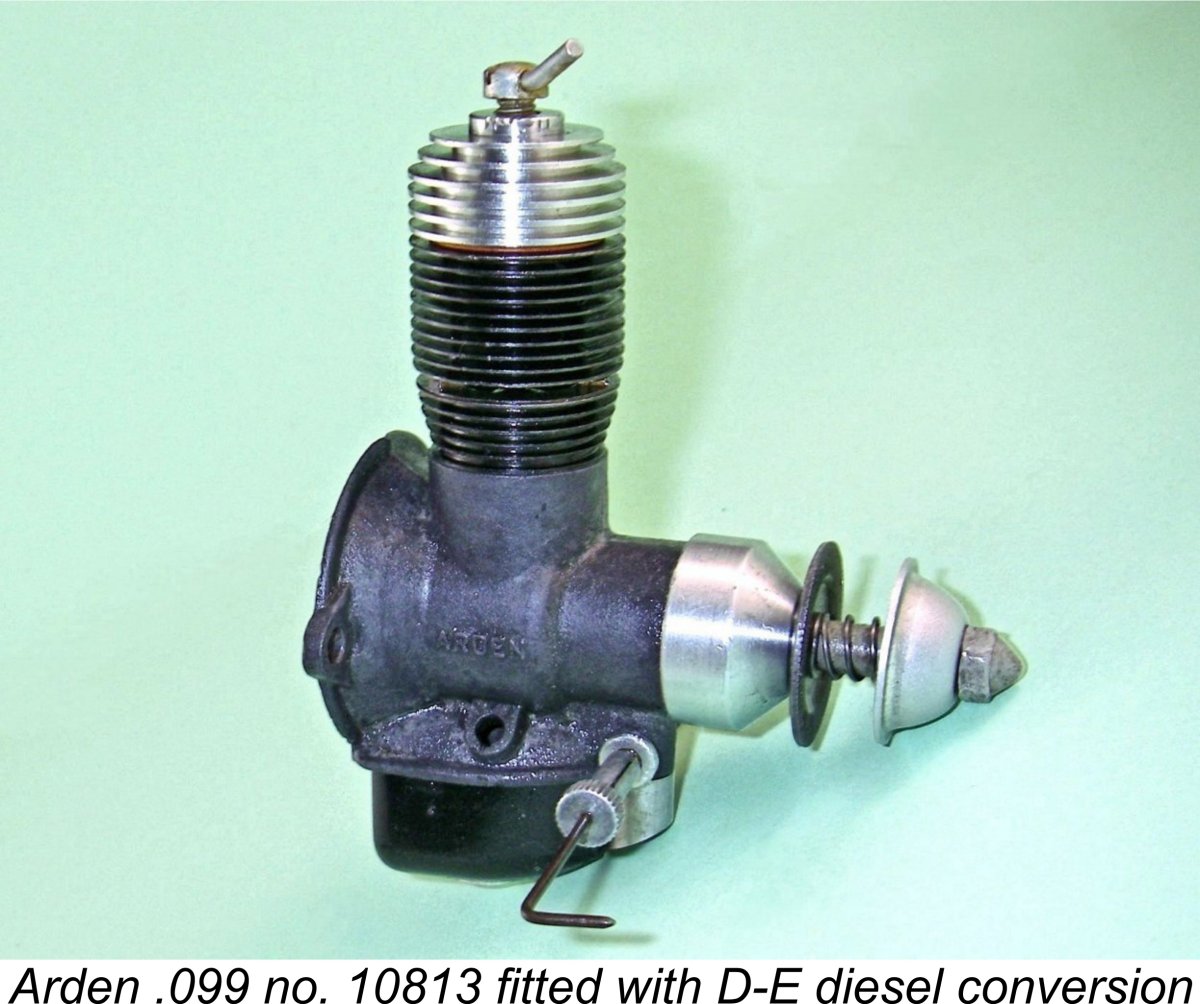 Here we'll share a look at one of the “forgotten” American diesels from the strangely under-appreciated early post-WW2 period during which America engaged in what was to prove to be a very brief but remarkably productive flirtation with model compression ignition engines. Specifically, we’ll be evaluating the application of compression ignition technology to the famous Arden .099 spark ignition engine by a company called D-E Model Products.
Here we'll share a look at one of the “forgotten” American diesels from the strangely under-appreciated early post-WW2 period during which America engaged in what was to prove to be a very brief but remarkably productive flirtation with model compression ignition engines. Specifically, we’ll be evaluating the application of compression ignition technology to the famous Arden .099 spark ignition engine by a company called D-E Model Products. 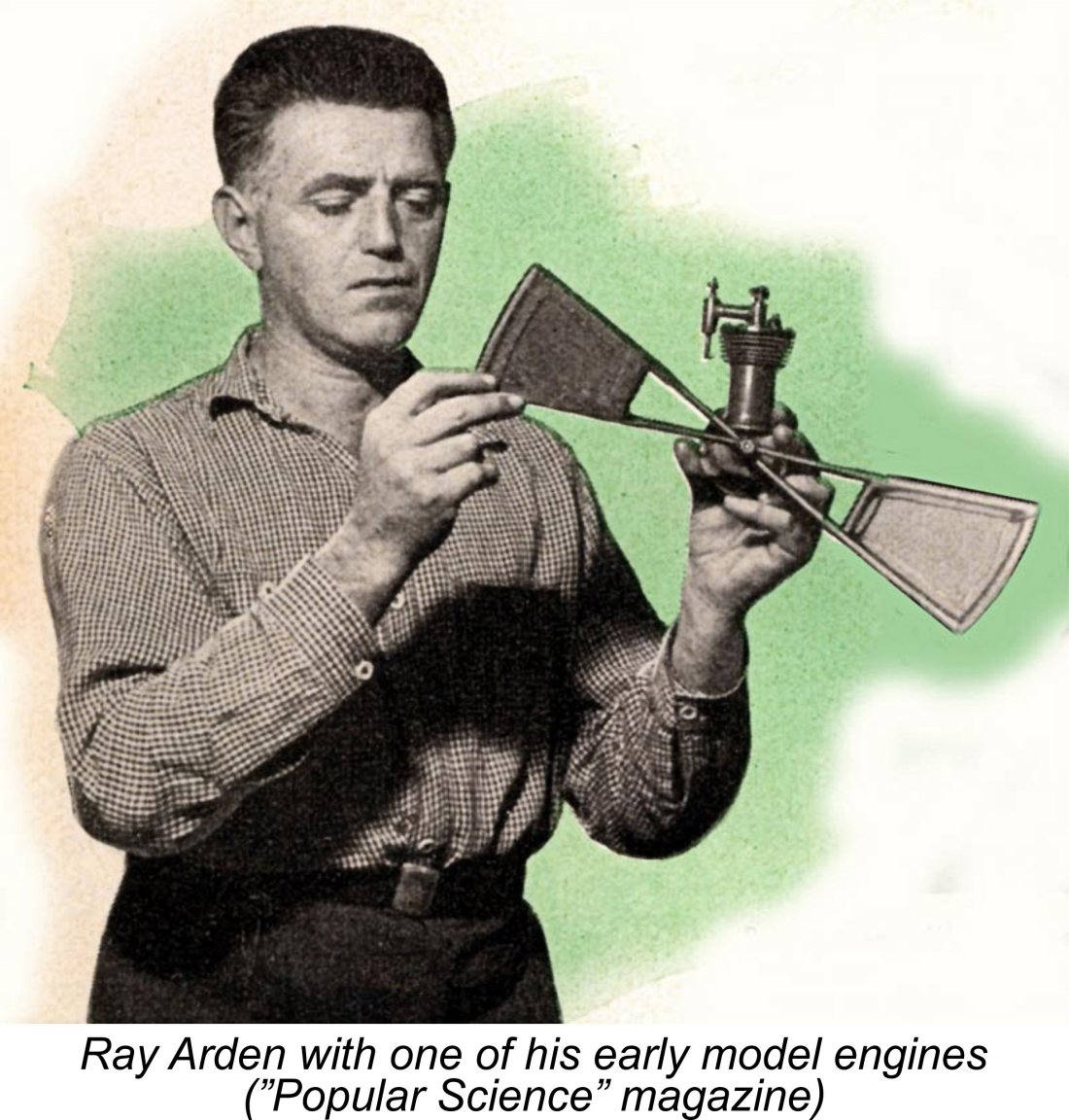 Few individuals have had a greater influence on model engine history than Thomas Ray Arden (who always went by his second name). Born in 1890, he built his first rubber-powered model airplane in 1901 and followed this up by designing and constructing his first I/C model aero engine in 1908 at the age of 18. How many 18-year olds today could complete such a project from scratch?!?
Few individuals have had a greater influence on model engine history than Thomas Ray Arden (who always went by his second name). Born in 1890, he built his first rubber-powered model airplane in 1901 and followed this up by designing and constructing his first I/C model aero engine in 1908 at the age of 18. How many 18-year olds today could complete such a project from scratch?!?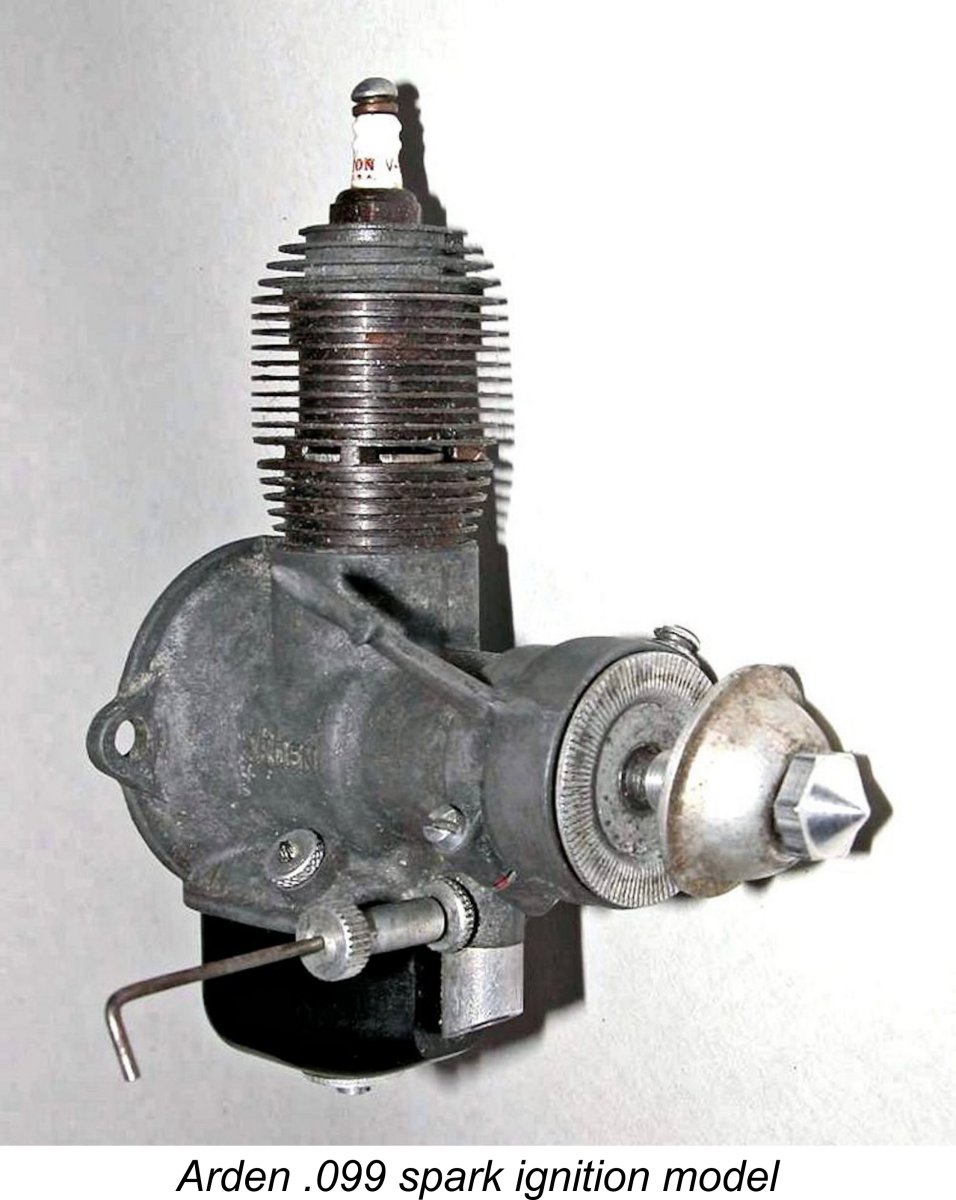
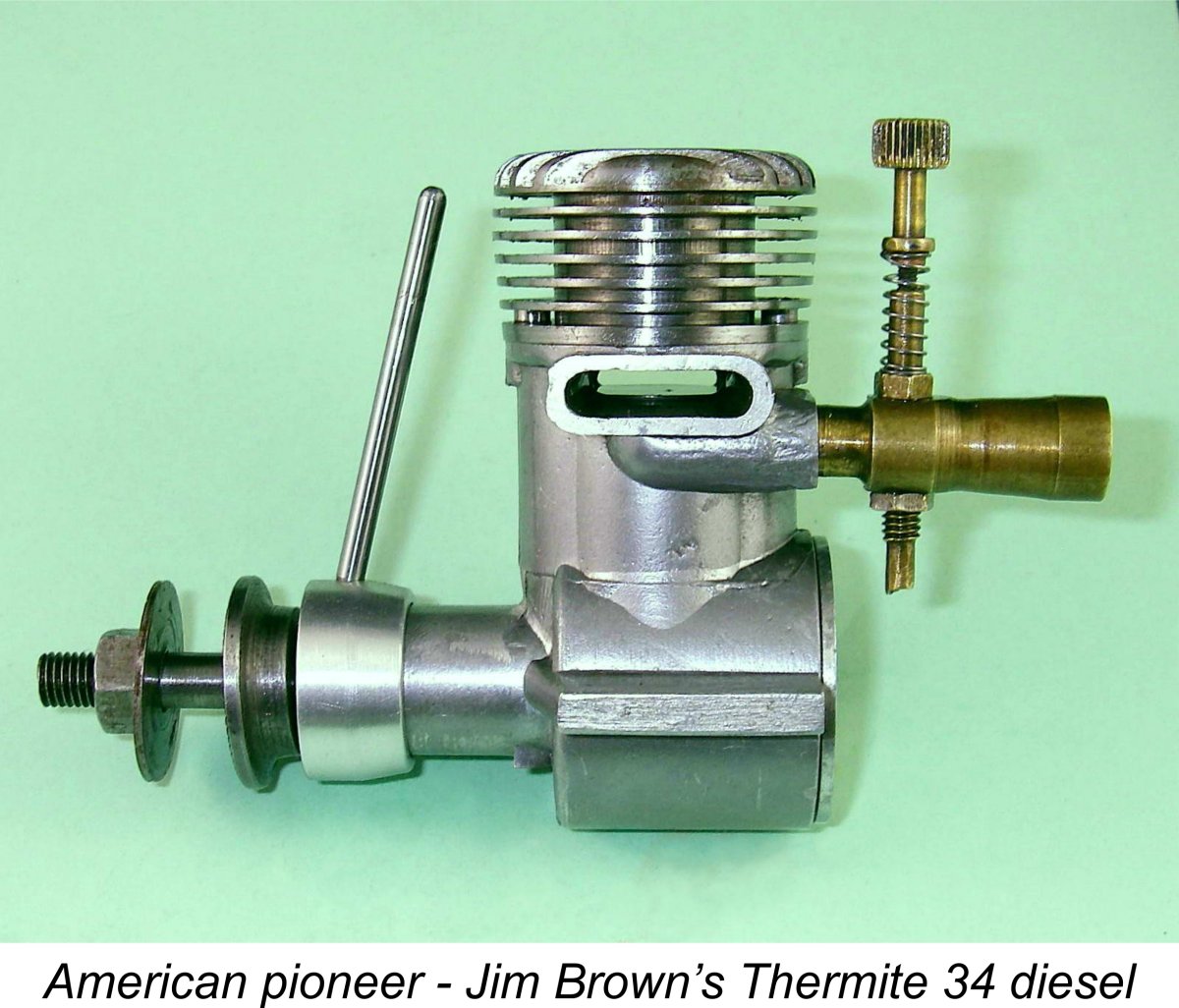 The fact that the model diesel did not require a heavy and potentially undependable airborne ignition support system gave it an obvious advantage over its spark ignition counterparts, particularly in the smaller and medium displacement categories. Naturally, this advantage was just as apparent to American modellers as it was to their European colleagues.
The fact that the model diesel did not require a heavy and potentially undependable airborne ignition support system gave it an obvious advantage over its spark ignition counterparts, particularly in the smaller and medium displacement categories. Naturally, this advantage was just as apparent to American modellers as it was to their European colleagues.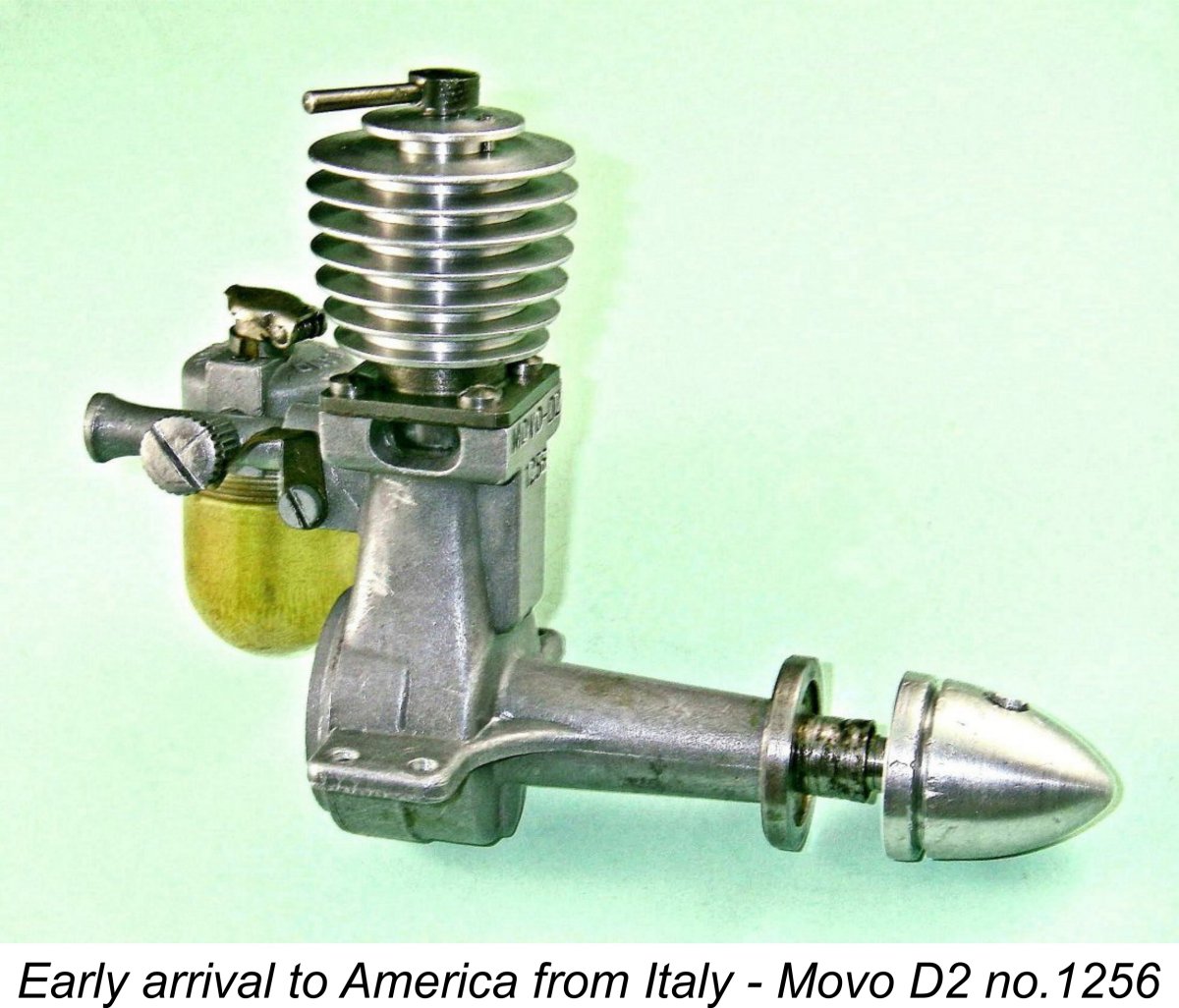 However, this was only the beginning! Interest in diesels among American modellers was stirred by the publication in the March 1946 issue of “Model Airplane News” (MAN) of an article on diesels by Jim Watson. Other articles soon followed in various US publications, all of them very positive in tone. It wasn’t long before such famous hobby supply houses as Polk’s were importing European diesels like the
However, this was only the beginning! Interest in diesels among American modellers was stirred by the publication in the March 1946 issue of “Model Airplane News” (MAN) of an article on diesels by Jim Watson. Other articles soon followed in various US publications, all of them very positive in tone. It wasn’t long before such famous hobby supply houses as Polk’s were importing European diesels like the 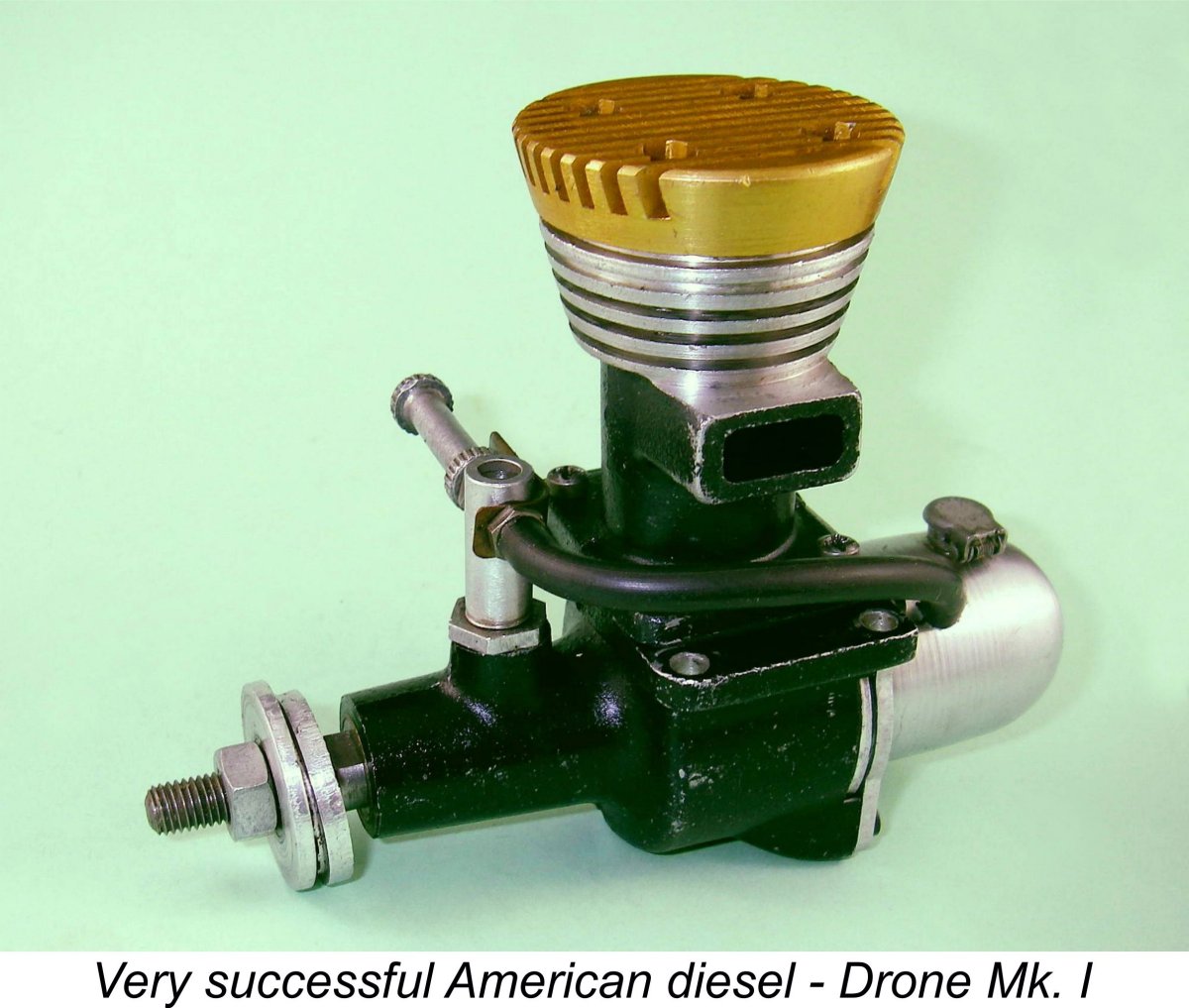 The C.I.E. was quickly followed by other American diesel designs, the most successful of which was Leon Shulman’s 5 cc
The C.I.E. was quickly followed by other American diesel designs, the most successful of which was Leon Shulman’s 5 cc 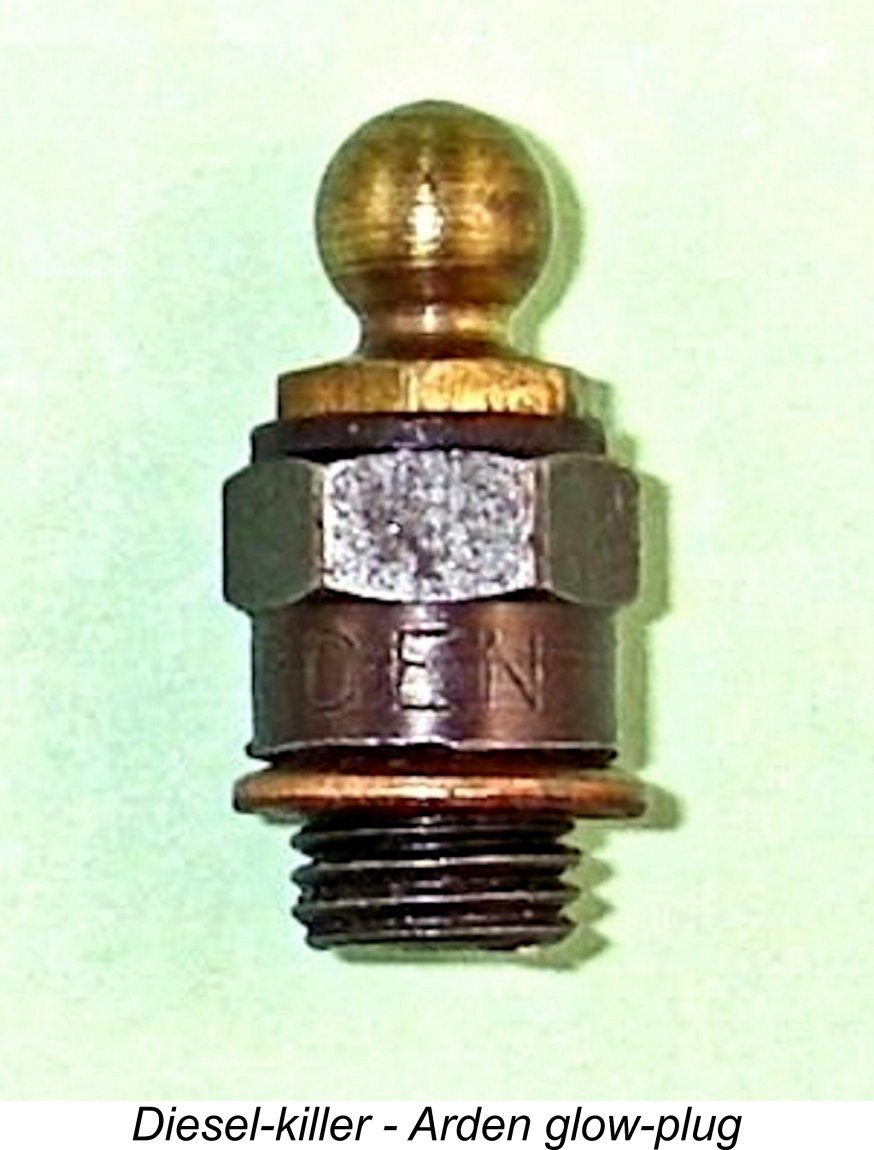 In a September 1947 advertising placement in MAN, a company called Aero Spark announced the introduction of a plug-in ground-based spark ignition support system for use with this operating approach. The fact that they saw some commercial potential in such an accessory seems to confirm that the technique was quite widely practised. However, Ray Arden's introduction of the commercial miniature glow-plug in the following month rendered this mode of operation instantly redundant. Alas for high hopes - a sad example of missing the boat ............
In a September 1947 advertising placement in MAN, a company called Aero Spark announced the introduction of a plug-in ground-based spark ignition support system for use with this operating approach. The fact that they saw some commercial potential in such an accessory seems to confirm that the technique was quite widely practised. However, Ray Arden's introduction of the commercial miniature glow-plug in the following month rendered this mode of operation instantly redundant. Alas for high hopes - a sad example of missing the boat ............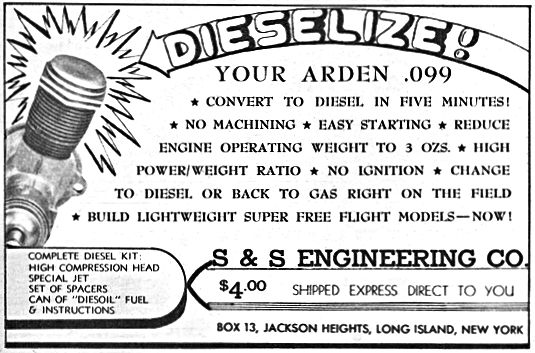 The famous and highly influential Arden engines have been described elsewhere in sufficient detail that their design features are generally very familiar to most model engine aficionados. Accordingly, I will confine my comments to a description of the D-E diesel conversion kit which forms our main subject here.
The famous and highly influential Arden engines have been described elsewhere in sufficient detail that their design features are generally very familiar to most model engine aficionados. Accordingly, I will confine my comments to a description of the D-E diesel conversion kit which forms our main subject here.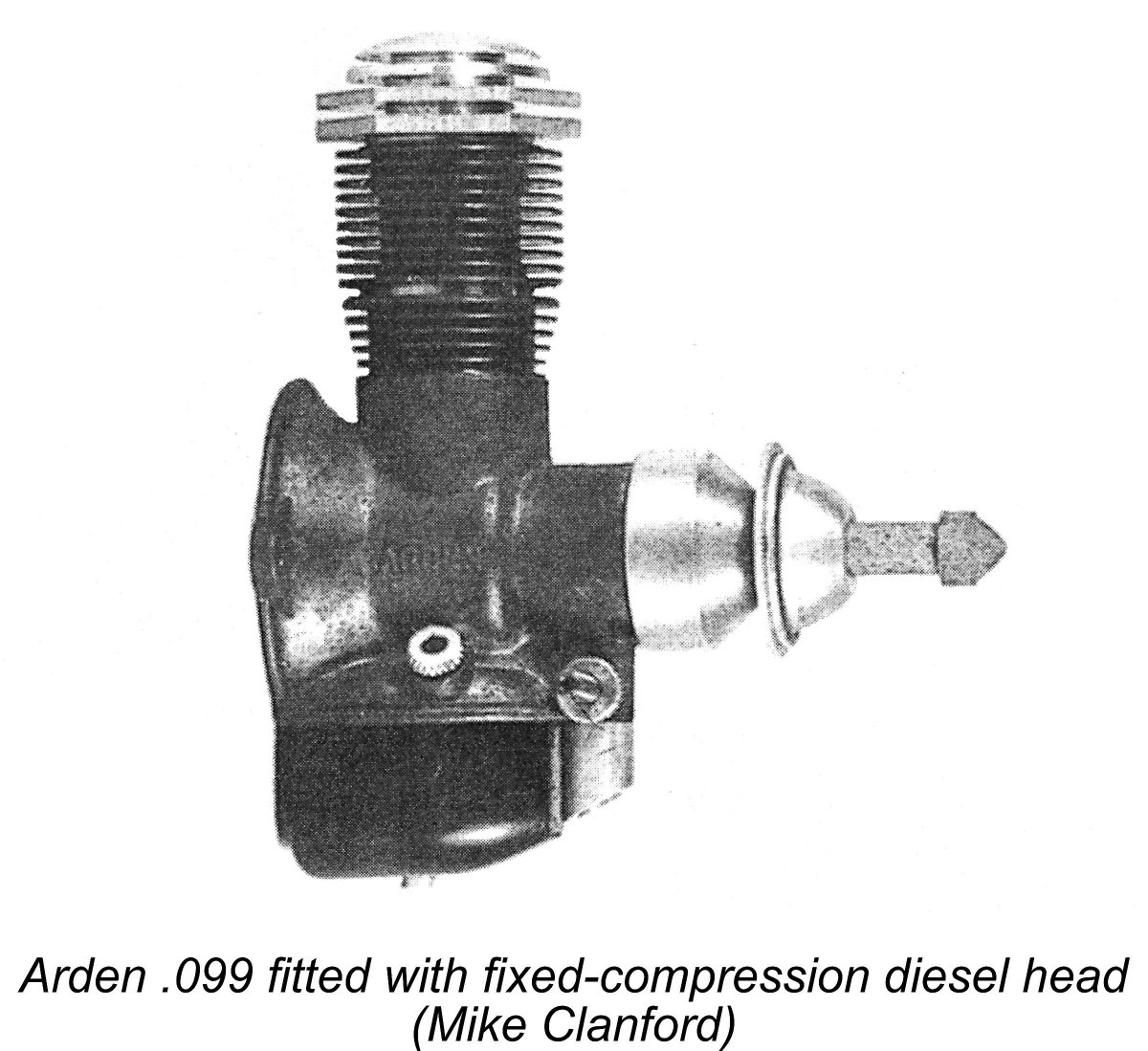
 However, the Arden engines were not really sturdy enough to withstand the stresses of
However, the Arden engines were not really sturdy enough to withstand the stresses of 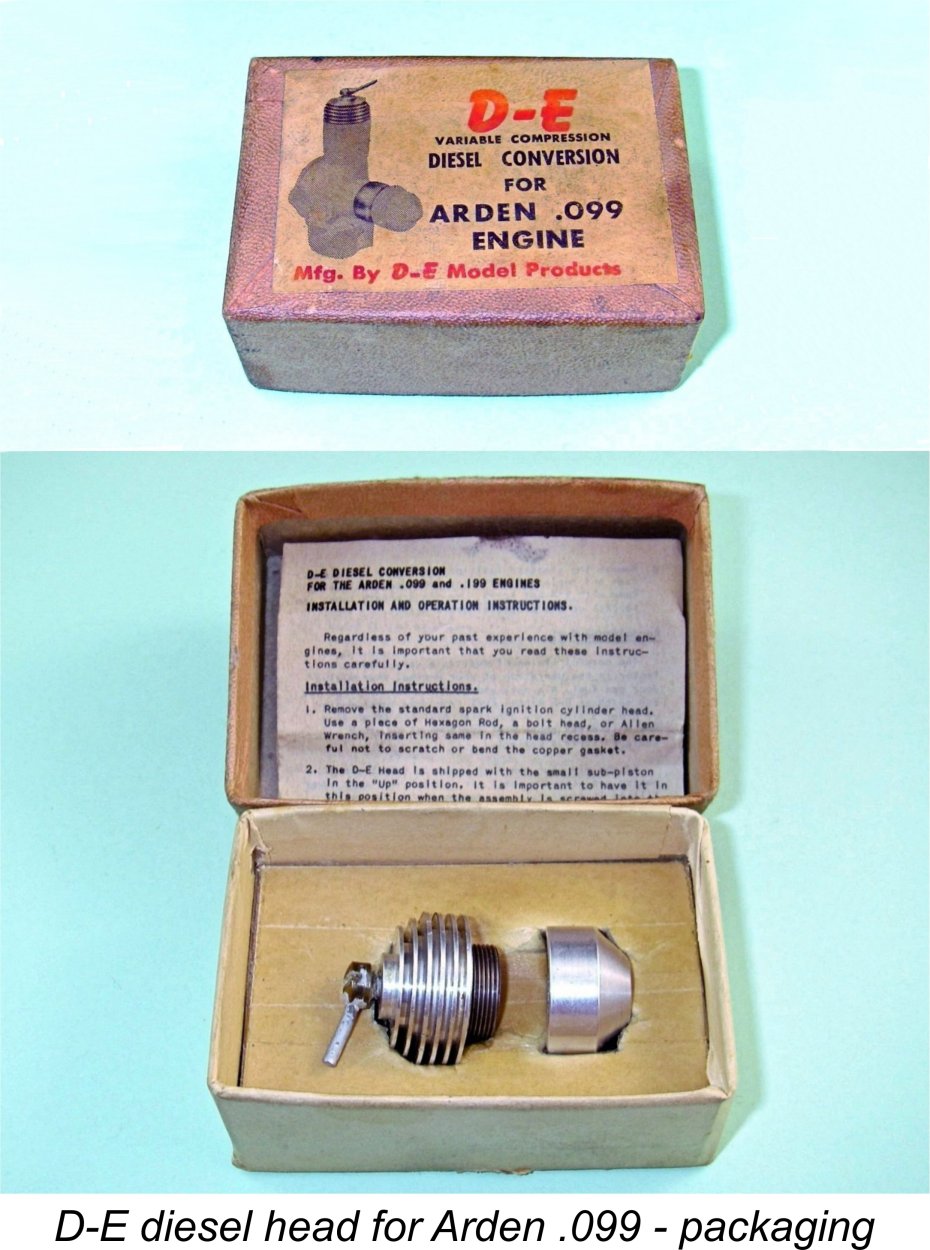 The D-E heads were supplied in small but sturdy cardboard boxes having a nicely-printed stick-on label. Upon opening the box, one found a comprehensive and well-written instruction sheet (if you could read the tiny type!) along with the diesel head itself plus an aluminium alloy cap which fitted over the front of the main bearing in place of the timer and was held in place with a set screw. The purpose of this component was clearly to protect the otherwise exposed front ball race from dust and dirt. A similar component was later supplied by Arden to replace the timer on their glow-plug models.
The D-E heads were supplied in small but sturdy cardboard boxes having a nicely-printed stick-on label. Upon opening the box, one found a comprehensive and well-written instruction sheet (if you could read the tiny type!) along with the diesel head itself plus an aluminium alloy cap which fitted over the front of the main bearing in place of the timer and was held in place with a set screw. The purpose of this component was clearly to protect the otherwise exposed front ball race from dust and dirt. A similar component was later supplied by Arden to replace the timer on their glow-plug models.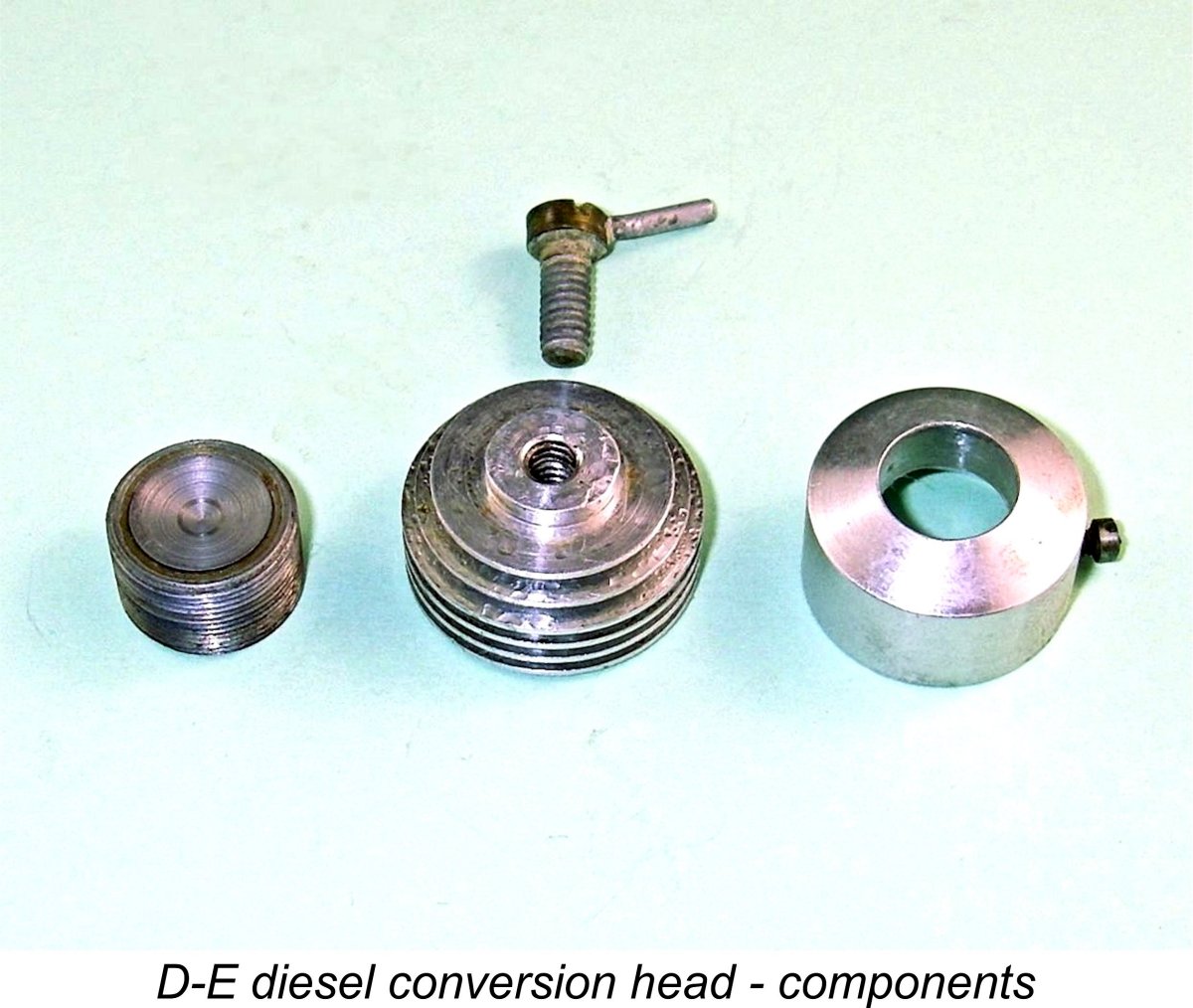 The D-E diesel conversion head itself was of considerable interest. It consisted of no fewer than four separate components – the alloy head itself; an externally-threaded steel insert which matched the internal installation threads in the head and upper cylinder and was bored right through; a lapped steel contra-piston which was closely fitted into this bore; and a compression screw. All of these components were machined to very high standards, with excellent fits all round.
The D-E diesel conversion head itself was of considerable interest. It consisted of no fewer than four separate components – the alloy head itself; an externally-threaded steel insert which matched the internal installation threads in the head and upper cylinder and was bored right through; a lapped steel contra-piston which was closely fitted into this bore; and a compression screw. All of these components were machined to very high standards, with excellent fits all round.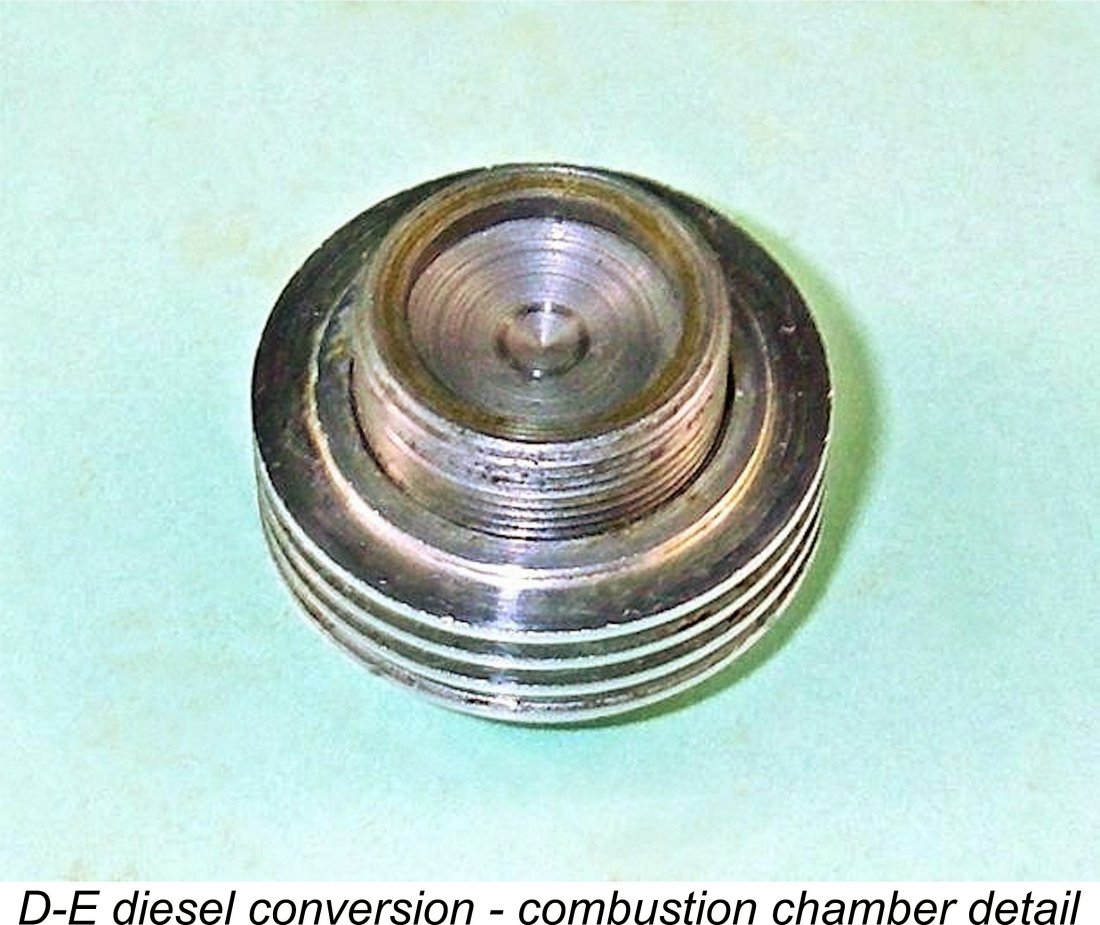 It should be noted that the ignition cam which is a separate slip-on component on the portion of crankshaft forward of the front ball race must be retained even though the timer is no longer used. This is because it also acts as the spacer for the prop driver.
It should be noted that the ignition cam which is a separate slip-on component on the portion of crankshaft forward of the front ball race must be retained even though the timer is no longer used. This is because it also acts as the spacer for the prop driver.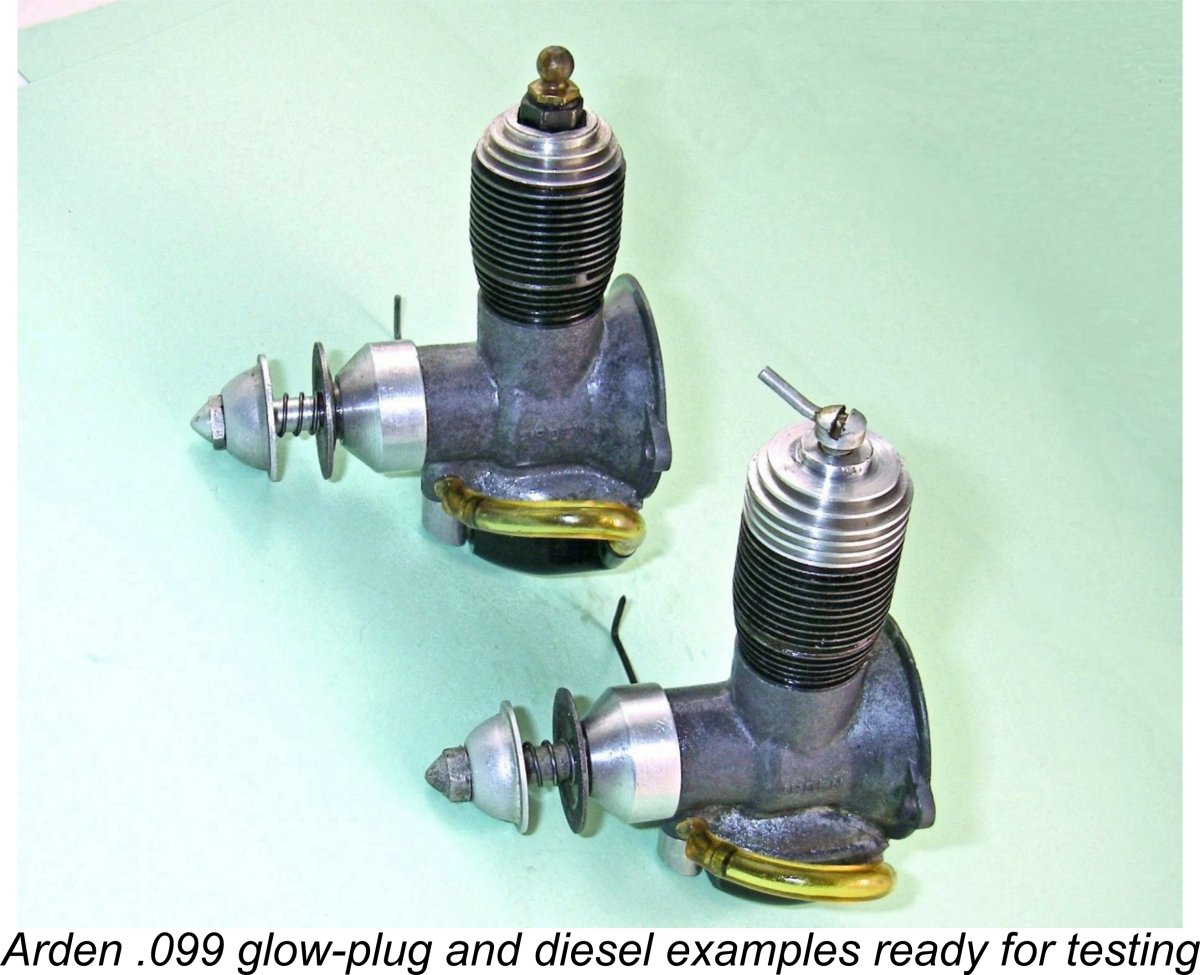 Since it was the almost immediate arrival on the scene of the commercial miniature glow-plug that put the brakes on the progress of diesel development in the USA, it seemed to me to be appropriate to test the D-E diesel conversion head against its glow-plug nemesis. Having both diesel-converted and glow-plug examples of the Arden .099 on hand, this was readily possible.
Since it was the almost immediate arrival on the scene of the commercial miniature glow-plug that put the brakes on the progress of diesel development in the USA, it seemed to me to be appropriate to test the D-E diesel conversion head against its glow-plug nemesis. Having both diesel-converted and glow-plug examples of the Arden .099 on hand, this was readily possible. 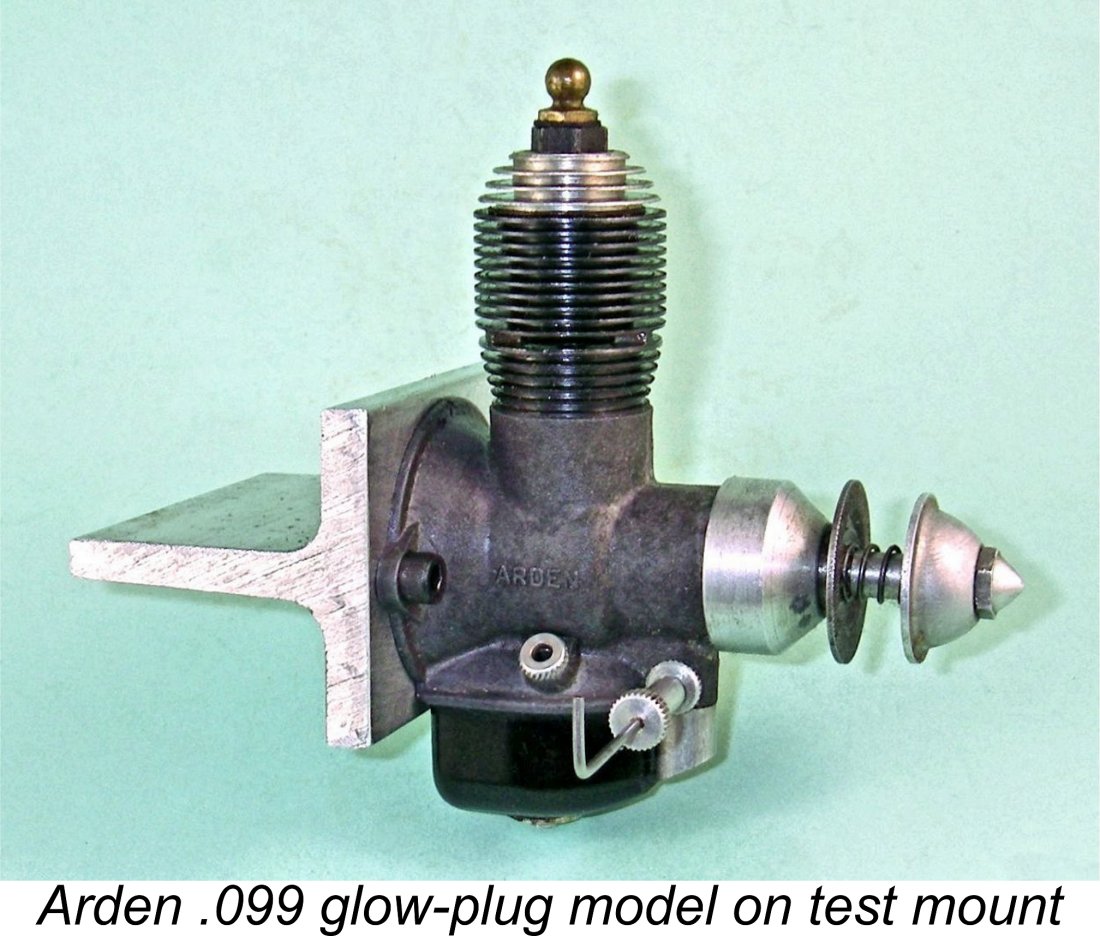
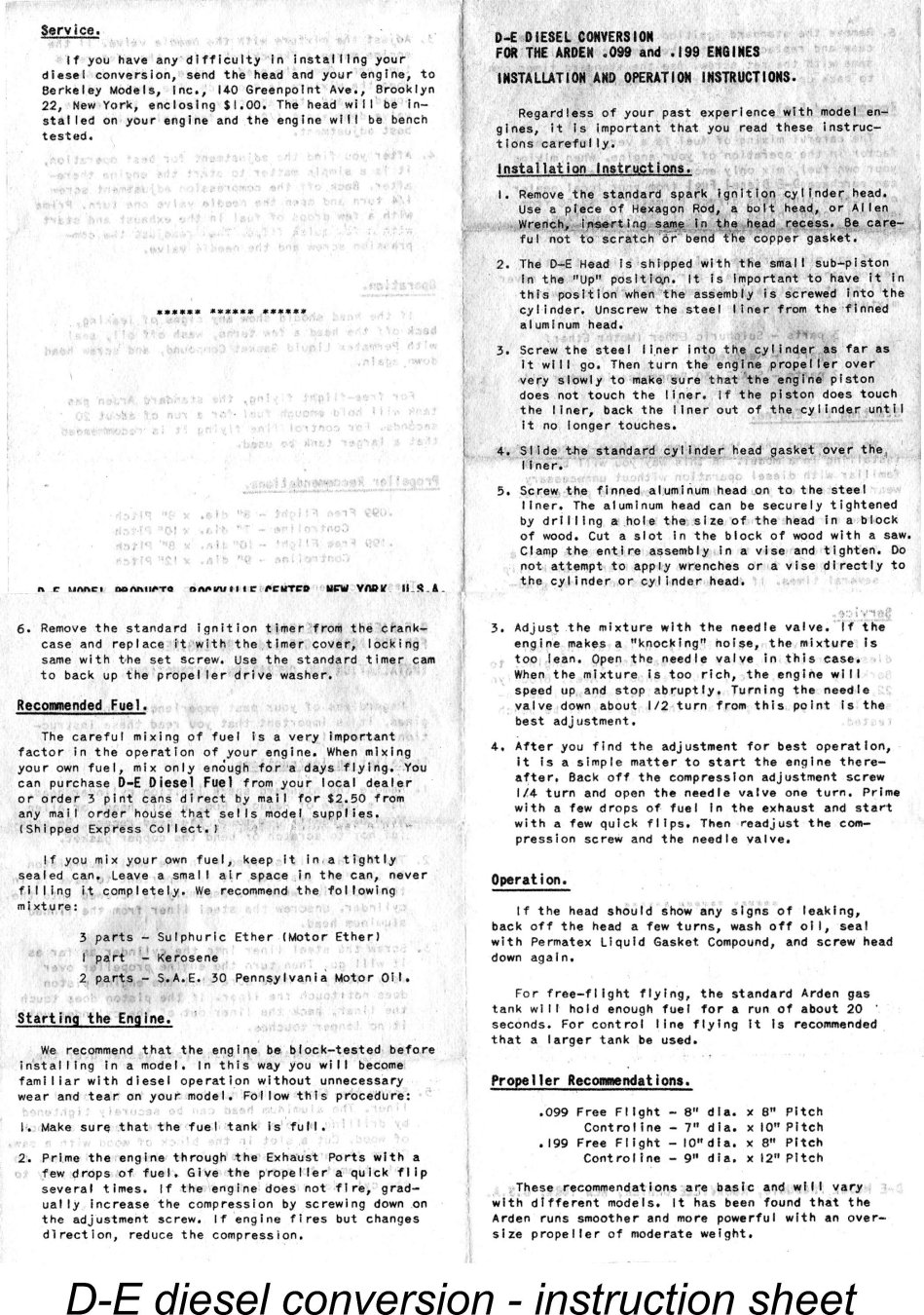
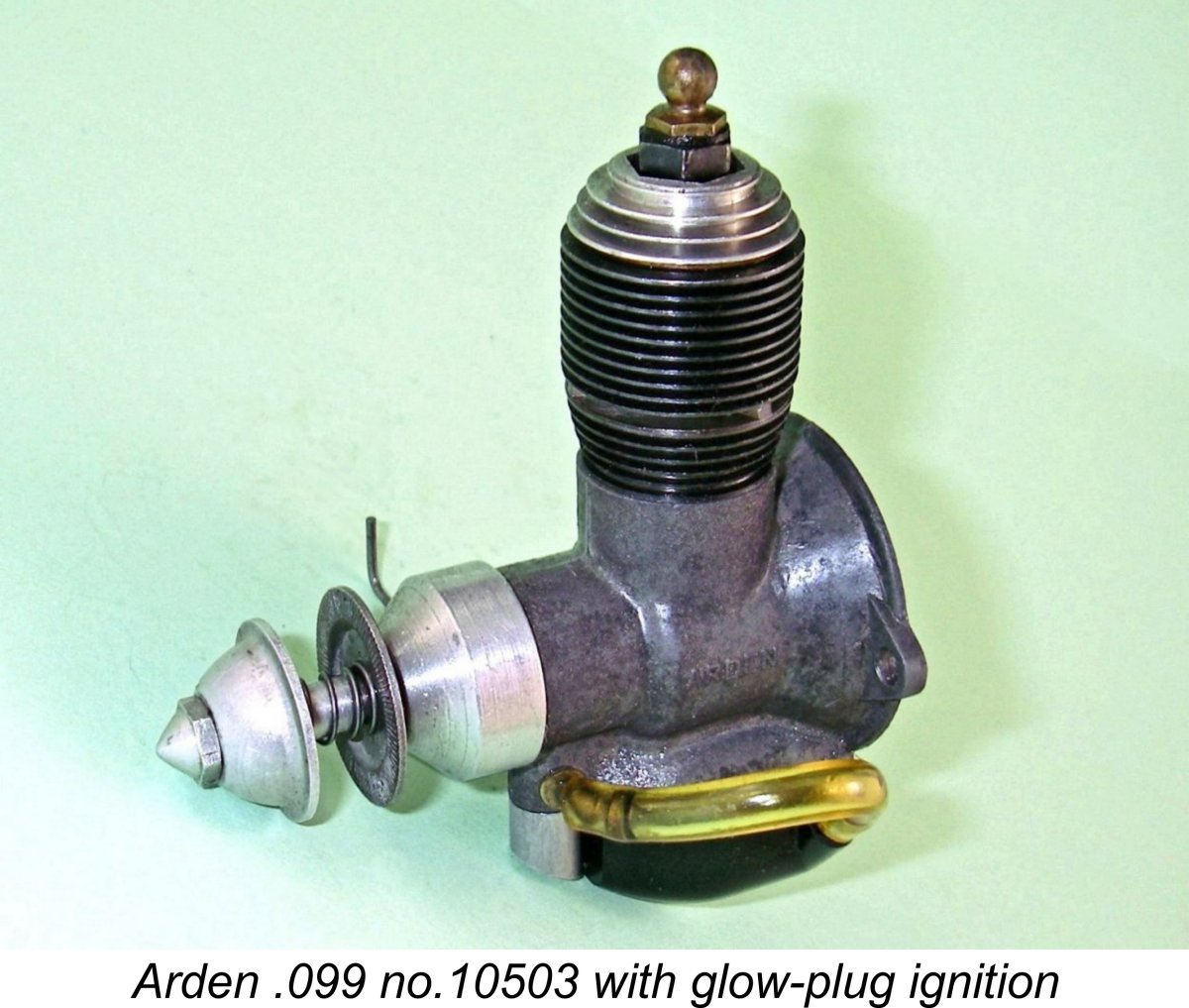
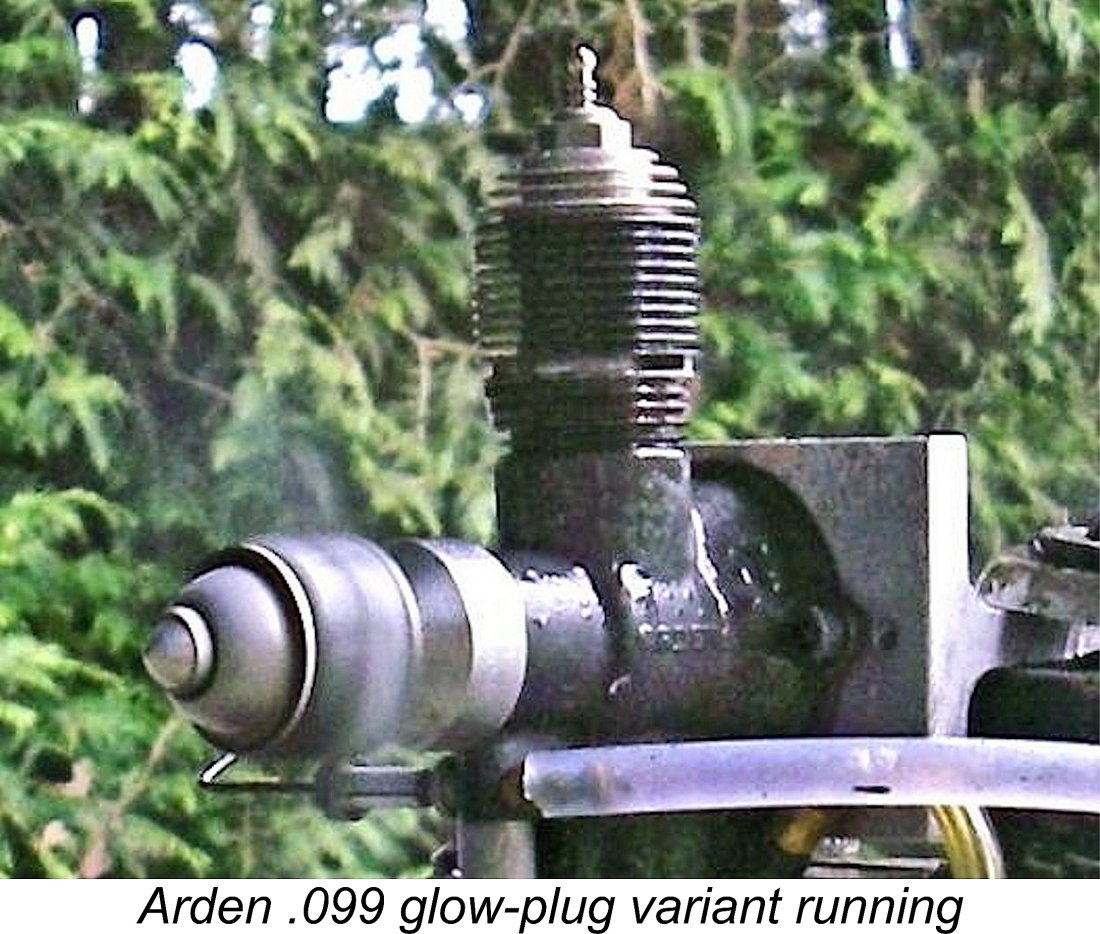 This technique turned out to work extremely well. The only difficulty that I had initially was the fact that the Arden's multi-flute bypass system and conical piston crown combine to encourage a port prime to run straight down into the crankcase without pooling on the piston crown. As a result, when the engine achieves its first firing burst it invariably begins in a very over-rich state, sometimes to the point where it floods to a halt.
This technique turned out to work extremely well. The only difficulty that I had initially was the fact that the Arden's multi-flute bypass system and conical piston crown combine to encourage a port prime to run straight down into the crankcase without pooling on the piston crown. As a result, when the engine achieves its first firing burst it invariably begins in a very over-rich state, sometimes to the point where it floods to a halt. 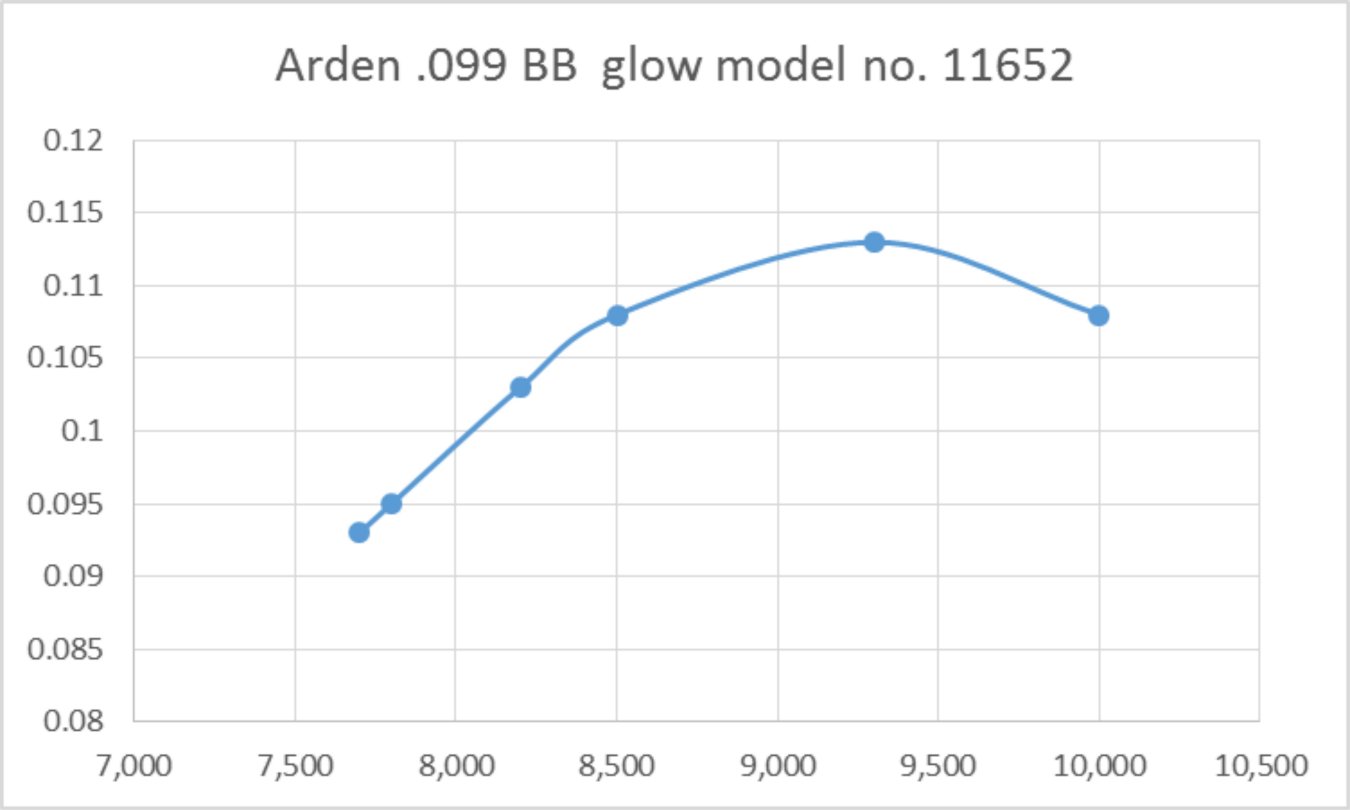
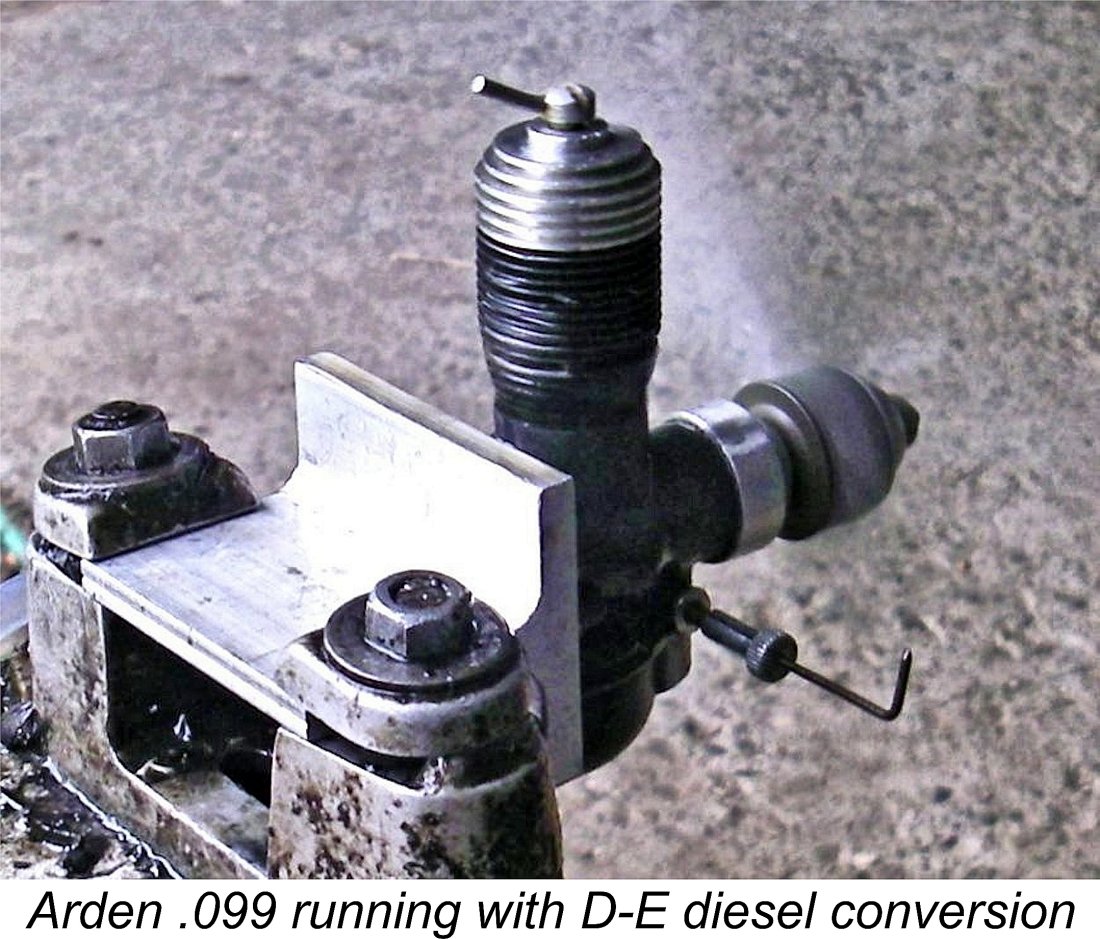 In embarking on this phase of the testing, I had the advantage of having experienced the characteristics of the glow-plug version beforehand. Hence I knew about the ease with which the crankcase could become floooded through excessive port priming. It was evident that modest priming would be the order of the day - in fact, a "dry" prime with the exhaust closed seemed to be the best way to proceed.
In embarking on this phase of the testing, I had the advantage of having experienced the characteristics of the glow-plug version beforehand. Hence I knew about the ease with which the crankcase could become floooded through excessive port priming. It was evident that modest priming would be the order of the day - in fact, a "dry" prime with the exhaust closed seemed to be the best way to proceed. 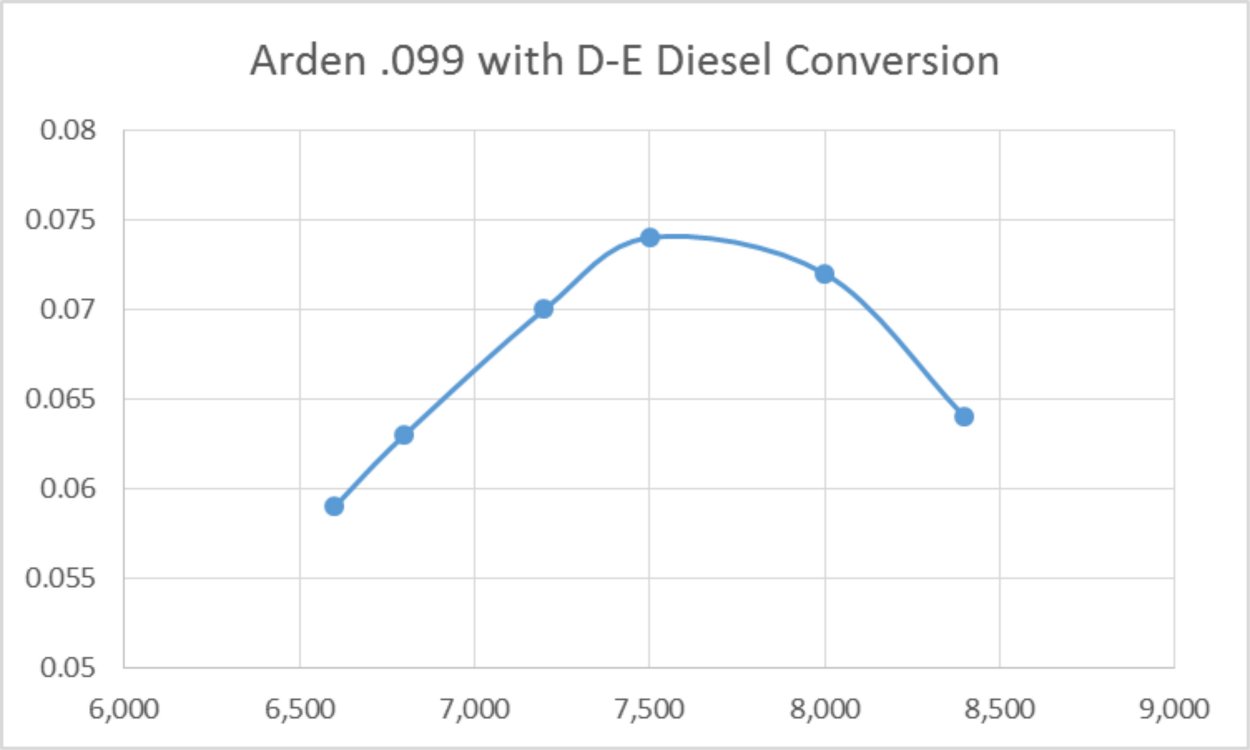
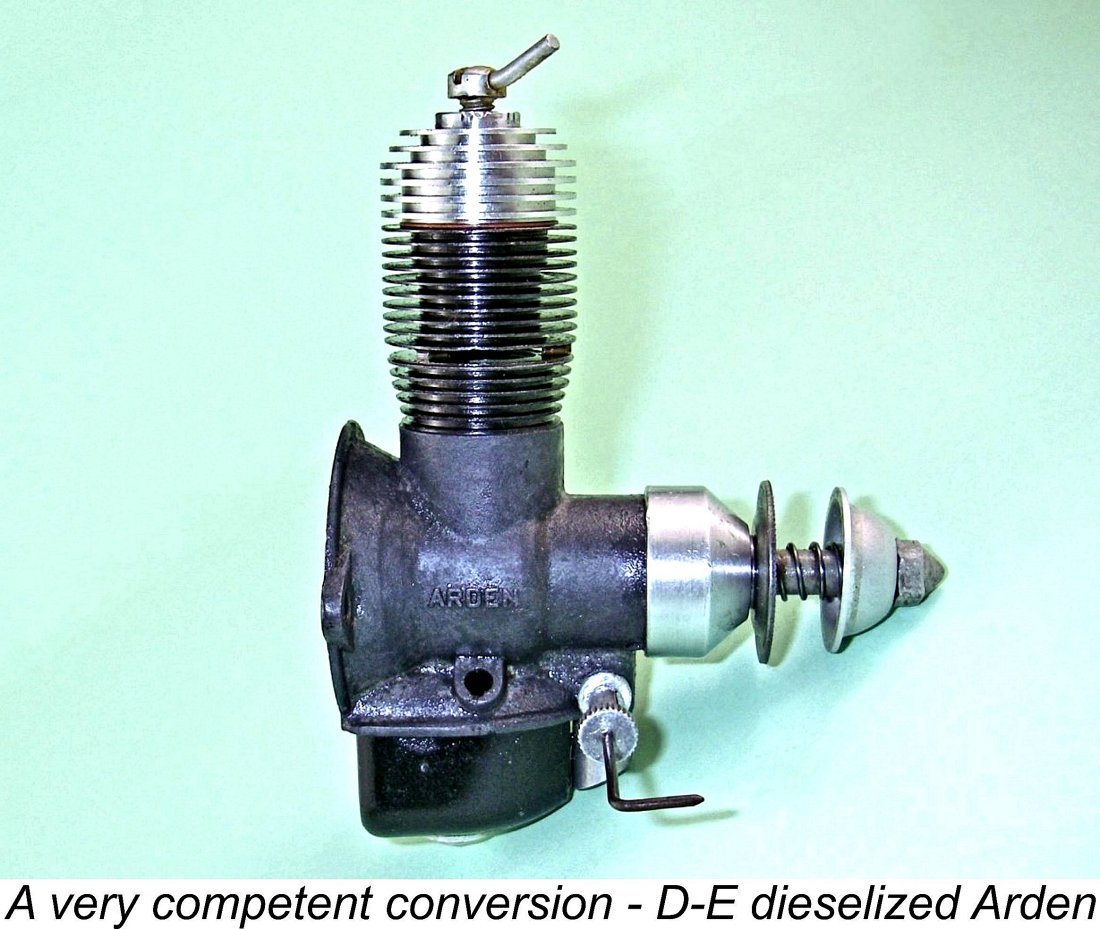 Finally, there's the issue of the fuels used to conduct the above tests. The diesel was tested on a fuel in which 5% of the kerosene had been replaced with extra oil. That would make it a relatively low-powered fuel, albeit very kind to the engine. By contrast, the glow-plug variant was tested on a methanol-based fuel containing only 25% oil and 10% nitro. I would expect that fuel to deliver a fairly sprightly performance!
Finally, there's the issue of the fuels used to conduct the above tests. The diesel was tested on a fuel in which 5% of the kerosene had been replaced with extra oil. That would make it a relatively low-powered fuel, albeit very kind to the engine. By contrast, the glow-plug variant was tested on a methanol-based fuel containing only 25% oil and 10% nitro. I would expect that fuel to deliver a fairly sprightly performance! 
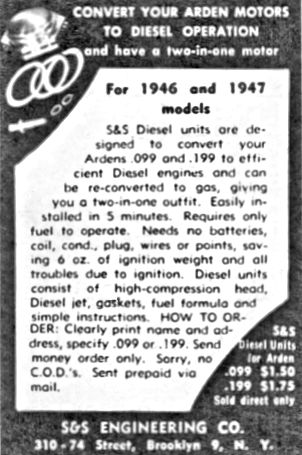 The D-E diesel head
The D-E diesel head